Bulletin – May 2004 Statement on Monetary Policy
Download the complete Statement 690KB
Developments so far in 2004 suggest that the international economic climate is continuing to improve. In Australia, growth remains solid, and a turning point appears to have been reached in the housing market after the overheated levels of late last year, though it is still unclear how this will evolve. These developments suggest a lessening of the main risks to the Australian economy, and improve the prospects for more balanced growth in the period ahead.
International events in recent months have been dominated by the US economy, where stronger employment data have helped to confirm that the recovery is becoming more firmly established. With business investment and profits growing strongly and business confidence high, the US recovery has now broadened well beyond its initial reliance on consumer spending. Another important development in the US has been a pick-up in the latest inflation figures. While core inflation remains low at this stage, it is looking increasingly likely that the downward trend evident over the past year or two has ended. As discussed below, financial markets viewed these events as bringing forward the likely timing of monetary policy tightening in the US.
Data from other parts of the world, with the exception of the euro area, also point to increased momentum in recent months. China's economy is growing at an exceptional pace, prompting the Chinese authorities to express concerns about overheating and to take action aimed at restraining the growth of bank lending. The Japanese economy is enjoying its strongest growth for a decade, and other parts of east and south Asia are also experiencing strong economic conditions, helped in part by the growth in China, the US and other export markets. In addition, these countries, which effectively form part of a ‘dollar bloc’, are receiving considerable stimulus from low interest rates and from the lower US dollar. Conditions in the euro area remain disappointing, though they are probably consistent with modest growth in GDP in the first quarter of 2004, about the same as in the two previous quarters.
Taken together, these developments confirm that the global economy has picked up significantly over the past year. This situation has put upward pressure on international commodity prices, many of which have increased considerably over this period, particularly in the resources sector, a trend that will benefit Australian exporters.
The main factor influencing financial markets in recent months has been changing assessments of the timing of the first interest rate increase by the US Fed. Earlier in the year, the prospects for a rate increase seemed to diminish after the publication of relatively weak job numbers. Over the past month, expectations of a rate increase have been brought forward again. This started with the release of a strong March employment report, and was reinforced by the subsequent publication of other strong economic data and a relatively large increase in the CPI. Markets now think that there is some chance that the Fed will raise rates at its late June meeting, and have fully priced in a move by the time of its mid-August meeting.
Talk of US monetary tightening over the past month prompted a rise in market interest rates in Australia, particularly for longer-term securities, and a fall in the exchange rate of the Australian dollar. However, markets have taken the view that any flow-through of rises in US interest rates to Australia should be limited, as Australian rates are already close to normal levels. The normalisation of interest rates by the Fed is therefore expected to result in a narrowing of the interest rate differential between the two countries, especially at the short end. The exchange rate has declined recently and is now around 9 per cent below its mid-February peak against the US dollar; in trade-weighted terms it has fallen by a smaller amount, as some of the fall against the US dollar has been a reflection of recent US dollar strength.
Economic data in Australia indicate that the economy has continued to grow solidly in 2004, in line with the outlook described in the February Statement. Household spending has been strong over the past year, though easing a little in the most recent months. Consumer confidence is close to its highest level in a decade and consumer spending is likely to continue to be supported by rising employment and real wages. In the housing construction industry, forward indicators continue to suggest a mild easing in activity later in the year, though its extent will be mitigated by a large stock of work yet to be done and strong demand for renovations. Broader indicators of the growth of the economy have remained firm in 2004. Employment has registered further sizeable gains, continuing a run of generally strong figures since around the middle of last year, while the unemployment rate has fallen further. Business surveys reported above-average conditions in the March quarter, though down a little from the end of last year.
Present indications are that overall growth of the economy is likely to remain strong, with the mix between domestic and external sources of growth shifting to a more sustainable position over time. The growth of domestic demand, though still strong, is likely to ease from the unusually rapid pace seen in the past couple of years. At the same time, with international data indicating a significant expansion in most parts of the global economy, a more favourable environment for export growth is emerging. Consistent with this, export volumes have resumed growth from the trough reached in the June quarter of 2003, though this is partly attributable to the recovery in rural exports from drought-affected levels.
The main source of risk to the export outlook apparent in the recent period has been associated with the appreciation of the exchange rate, and particularly the rapid appreciation that took place during 2003 and into the early weeks of this year. Had it continued, this posed the risk of significantly dampening the effects of the global recovery on Australia's export performance. But, with the exchange rate having drifted lower recently and the prospect of US interest rates starting to return to normal, this risk now seems less severe than a few months ago. A further risk, which seems to have increased recently, is that persistent dry conditions in a number of parts of the country may set back prospects for further recovery in the farm sector.
Australia's inflation rate for the present is still being held down by the effects of last year's exchange rate appreciation. In the March quarter the CPI increased by 0.9 per cent and by 2.0 per cent over the year. While this outcome was slightly higher than expected, the annual inflation rate has declined over the past year from a peak of just over 3 per cent. There continues to be a sharp contrast between externally and domestically sourced inflation pressures. Reflecting the exchange rate appreciation, prices of tradable items declined over the latest year, while domestically sourced inflation pressures remained relatively strong, with prices of non-tradable items continuing to rise at an annual rate of around 4 per cent. The Bank's assessment remains that the pass-through of these exchange rate effects will dampen inflation a little further over the coming year and that inflation will then start to increase gradually as these effects fade. Inflation is now expected to decline to around 1¾ per cent at the end of this year, rising to around 2½ per cent by the end of 2005.
The other major source of risk to the general economic outlook in Australia is associated with developments in credit growth and in the housing market. The run-up in credit growth and the associated boom in house prices in recent years presented two implications for the economy: they tended to boost growth in the short term, but carried the risk of a damaging correction if they continued too long.
With the heat now coming out of the credit and housing markets, this risk has diminished over recent months. Housing finance approvals peaked at around $15 billion a month in October, and have since declined to around $12 billion recently. This is still a very high level and will need to fall much further to bring the growth of housing credit back to a reasonably sustainable pace. Nonetheless it is encouraging that housing finance has at least begun the process of correcting from the exceptionally high levels reached last year. There are also recent indications that house prices may have reached their peak. After the rapid increases recorded during 2003, available indicators for the March quarter 2004 point to falling prices in most of the major cities, although much of the information is still preliminary at this stage. In addition, auction clearance rates remain well down on a year ago, suggesting that vendors' price expectations are not being met.
Following the two increases in the cash rate at the end of 2003, the Board considered at its subsequent monthly meetings whether there was a case to increase rates further. One consideration was that, with the cash rate having been increased by a total of 100 basis points since mid 2002, the amount of monetary stimulus to the economy was now significantly reduced. A further consideration was the unfolding adjustment in housing finance and house prices. As has been discussed in previous Statements, the medium-term risk associated with overheating in this part of the economy had been taken into account in the decisions to raise the cash rate late last year. While this factor was not the principal driver of policy, it had been an important reason to avoid unnecessary delay in moving the cash rate back up to a more normal position. The adjustment now underway in housing finance reduces this source of risk to the economy, but it is still too early to predict how it will unfold.
It is advantageous that this adjustment is occurring at a time when the broader macroeconomic situation is favourable. The Australian economy is growing solidly and inflation for the present is relatively low, though likely to rise next year. The international recovery has gained strength, which will be helpful to Australia's exporters, and the risks to the export sector from the rapidly rising exchange rate have lessened.
Overall then, while the risks to the economy have not gone away entirely, developments over recent months suggest that the chances of achieving well-balanced growth and a more restrained pace of credit expansion have improved. In these circumstances the Board decided at its recent monthly meetings to hold the cash rate unchanged. In its deliberations on monetary policy, the Board will continue to monitor all these developments and make adjustments as required, with a view to achieving sustainable growth in the medium term with low inflation.
International Economic Developments
The recovery in the world economy has continued at a brisk pace into the early part of 2004, particularly in the US and east Asia. In its latest assessment of the international outlook, released in late April, the IMF forecasts that growth in the G7 countries will pick up from 2.2 per cent in 2003 to 3.5 per cent in 2004, which is well above the trend rate of around 2½ per cent (Table 1). Conditions in emerging economies are even stronger than for industrialised countries (Graph 1). World GDP growth is therefore expected to accelerate from 3.9 per cent in 2003 to 4.6 per cent in 2004, which would be among the fastest rates of growth experienced in the past 30 years. On IMF projections growth will moderate slightly in 2005, but is expected to be a little more evenly spread across regions.
| 2002 | 2003 | 2004 | 2005 | |
|---|---|---|---|---|
| IMF forecasts (April 2004) | ||||
| United States | 2.2 | 3.1 | 4.6 | 3.9 |
| Euro area | 0.9 | 0.4 | 1.7 | 2.3 |
| Japan | −0.3 | 2.7 | 3.4 | 1.9 |
| China | 8.0 | 9.1 | 8.5 | 8.0 |
| Other east Asia(a) | 4.6 | 3.7 | 5.4 | 5.1 |
| G7(b) | 1.4 | 2.2 | 3.5 | 3.0 |
| World(b) | 3.0 | 3.9 | 4.6 | 4.4 |
|
(a) GDP weights Sources: IMF; RBA |
||||
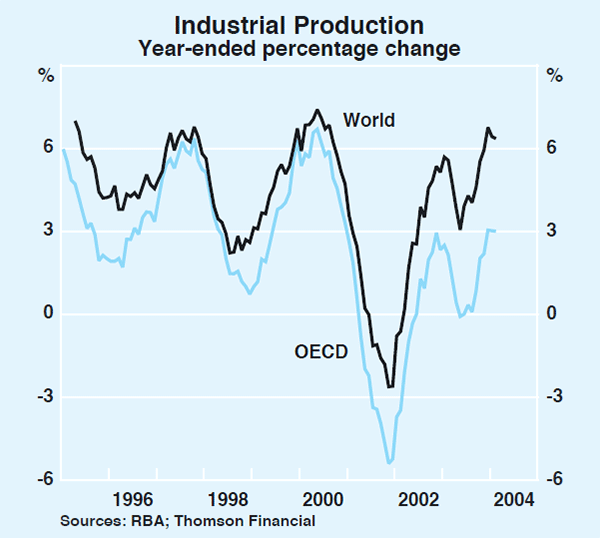
United States
The US economy continues to grow strongly, spurred by accommodative fiscal and monetary policy settings, together with the depreciation of the US dollar over the past year or so. After rising very strongly in the second half of last year, GDP grew by 1.0 per cent in the March quarter, to be 4.9 per cent higher than a year earlier (Graph 2). There are now also clear signs of improvement in the labour market.
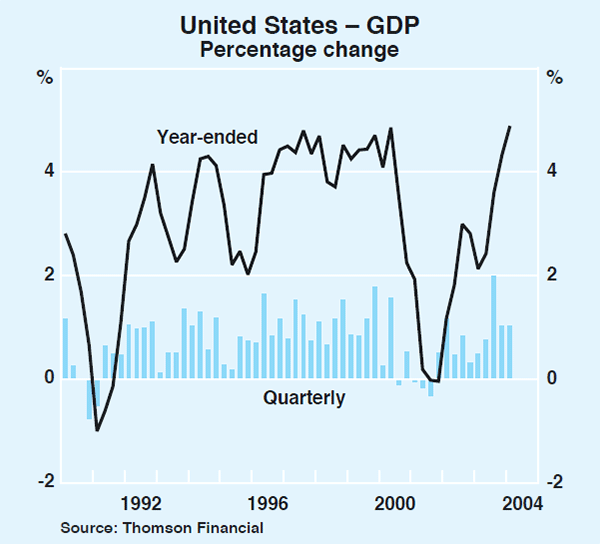
The labour market had been viewed as the main cloud over the US economy, with some surprisingly soft outcomes for non-farm payrolls employment in late 2003 and early 2004. However, payrolls data for March showed an increase of 308,000 jobs, with upward revisions to earlier months resulting in an average increase over the previous couple of months of around 100,000 jobs (Graph 3). This suggests that the recovery occurring in the rest of the economy is now beginning to flow through to the labour market. Most other labour market indicators are also pointing to further solid increases in employment. For example, weekly initial jobless claims are currently running at around the 345,000 level, which in the past has been consistent with monthly employment gains of around 150,000; the manufacturing ISM employment index is at a 20-year high; and growth in temporary-help services employment (which tends to lead overall employment) has picked up. Much of the weakness in payroll employment has been in the manufacturing sector, but this sector has strengthened recently.

Despite the generally lacklustre state of the labour market until quite recently, household consumption was again an important source of growth in the March quarter, rising by 0.9 per cent in the quarter and by 4.3 per cent over the year. Household spending has been supported by low interest rates, rising household wealth and recent tax cuts. Household wealth rose by 5.1 per cent in the December quarter, reflecting rising house and share prices, to be 11.7 per cent higher over the year.
In the business sector, conditions are very favourable and are driving an upswing in investment (Graph 4). Business investment rose by a further 1.7 per cent in the March quarter, following strong growth in the second half of 2003, to be 9.4 per cent higher than a year earlier. Equipment investment again led the way, particularly the information technology component. Looking forward, conditions seem supportive of continued strong investment growth. Corporate profits surged 7.2 per cent in the December quarter and by 29 per cent over the year, pushing the profit share of GDP to a level well above its long-run average. Business confidence is high, and balance sheets appear to be sound, with corporate gearing at a low level by historical standards. It also seems likely that inventory rebuilding will add to growth over 2004. Some rebuilding of inventories has already occurred over the past six months, but the inventories-to-sales ratio remains at a low level.
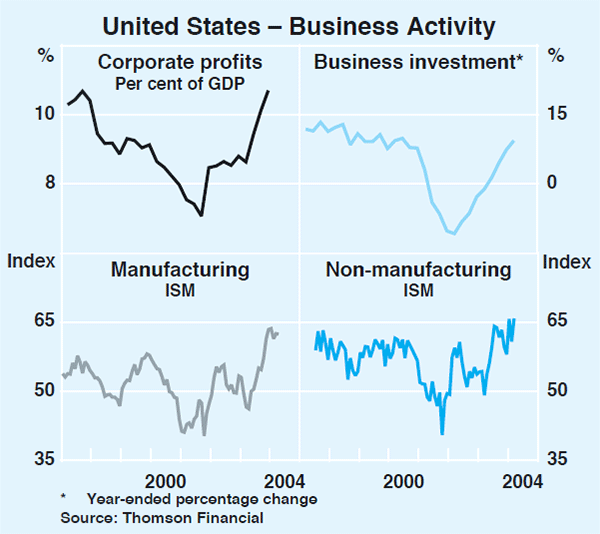
Strong productivity growth, combined with moderating wage growth and ample spare capacity in the economy, led to unit labour costs falling by 1.7 per cent over the year to the December quarter. However, more recent data show some modest pick-up in inflation. Core CPI inflation, which excludes the volatile food and energy components, picked up to 1.6 per cent over the year to March from a low of 1.1 per cent in late 2003.
Asia-Pacific
Japan
The economic situation in Japan is more promising than it has been for some time, and the economy now looks to be in a fairly healthy expansion phase. Real GDP increased by 1.6 per cent in the December quarter to be 3.6 per cent higher over the year (Graph 5). Much of the strength reflects ongoing growth in business investment and exports, which have been keying off strong corporate profitability and robust external demand, particularly from China. It is possible that measured GDP growth is somewhat overstated due to difficulties in estimating the GDP deflator, which is falling considerably more quickly than other price measures; nominal GDP has grown by a much more modest 0.8 per cent over the year, although this is still an improvement on recent history.
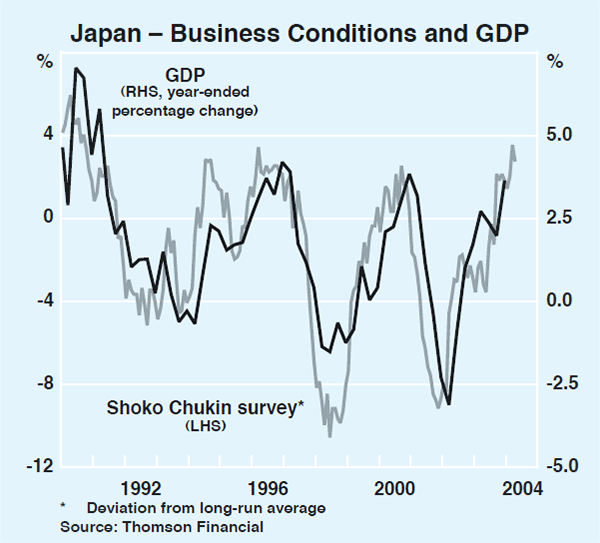
Notwithstanding the problems in estimating real GDP, other more timely data also point to a solid recovery in Japan. Both the Tankan survey and the Shoko Chukin survey of small business suggest conditions in the manufacturing sector are as strong as at any time in the past 15 years or so. After climbing sharply in late 2003, industrial production and merchandise exports have levelled out in early 2004, although both measures remain well up on levels recorded a year earlier. Moreover, firms are increasingly reporting that the upswing is broadening to the services sector where conditions had previously been more subdued.
Conditions in the household sector are also looking a little brighter, with signs of improvement in the labour market and rosier consumer sentiment supporting a revival in consumer spending. The unemployment rate has fallen from a peak of 5½ per cent in early 2003 to below 5 per cent currently – the first notable reduction in unemployment since the 1980s (Graph 6). Employment has risen over the past year and forward-looking indicators, such as the ratio of job offers to applicants, point to further gains in the near term. Trends in other indicators such as retail sales and household spending have also been somewhat more positive in the early part of 2004.
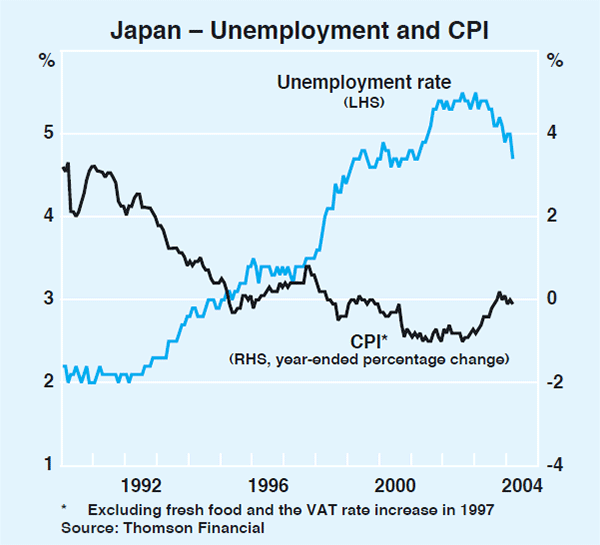
Consistent with the upturn in output growth, deflationary pressures continue to moderate, although this partly reflects some temporary factors such as a poor harvest boosting rice prices sharply. Consumer prices fell by 0.1 per cent over the year to March, compared with deflation rates of nearly 1 per cent in the past few years. Domestic corporate goods prices, a measure of wholesale and producer prices, have also stabilised in recent months largely due to the run-up in global commodity prices. Land prices continue to decline, falling by 6 per cent in 2003; this brings the total decline since 1991 to 48 per cent. Even so, there have been some signs of land prices levelling out in major urban areas such as central Tokyo.
Prospects for Japanese banks are also looking more positive recently. The demand for loans seems to be picking up, especially amongst smaller businesses, and banks have made further progress in writing off non-performing loans. According to official data, non-performing loans currently account for around 7½ per cent of bank lending, down from their peak of around 9½ per cent in early 2002.
Other Asia-Pacific
Supported by expansionary macroeconomic policy settings, stimulatory financial conditions and the recovery in the global economy, east Asia has bounced back strongly after the SARS-related weakness of the first half of 2003 (Table 2). While exports are growing very rapidly there has also been a healthy revival in domestic demand, back to the rapid rates typically seen prior to the financial crises of 1997–98. With many of these economies linking their exchange rates to the US dollar, growth has been boosted by the depreciation of the dollar and by low interest rates.
| September quarter 2003 |
December quarter 2003 |
March quarter 2004 |
Year to latest quarter |
|
|---|---|---|---|---|
| China | 4.3(a) | 2.3(a) | 3.3(a) | 9.7 |
| Hong Kong | 6.6 | 1.5 | – | 4.9 |
| India | 4.3 | 0.4 | – | 10.4 |
| Indonesia | 1.3 | 0.2 | – | 4.4 |
| Korea | 1.6 | 2.7 | – | 4.1 |
| Malaysia | 2.4 | 1.7 | – | 6.4 |
| Philippines | 2.2 | 1.6 | – | 4.4 |
| Singapore | 3.8 | 2.7 | 2.6 | 7.3 |
| Taiwan | 5.1 | 1.5 | – | 5.1 |
| Thailand | 2.3 | 2.7 | – | 7.8 |
|
(a) RBA estimates Sources: CEIC; RBA |
||||
In China, growth in activity appears to have maintained the extremely rapid pace seen last year, with GDP expanding by 9.7 per cent over the year to the March quarter. The Chinese authorities have expressed concern about overheating in some sectors of the economy, taking action to rein in credit growth and rebalance growth away from investment and towards greater household spending, but as yet there is little evidence that this is having the desired effect. Export growth has eased a little, following the surge in December 2003 as exporters sought to avoid the cut in tax rebates on 1 January, but growth over the year remains exceptionally strong at 43 per cent. Imports have also continued to grow strongly and as a result the trade balance was in deficit in the March quarter for the first time in eight years (Graph 7). Moreover, year-ended growth in industrial production picked up from 18.1 per cent in December to 19.4 per cent in March, and household consumption shows no signs of slowing.
The Indian economy has also continued to perform strongly, with year-ended GDP growth of 10.4 per cent recorded in the December quarter (see ‘Box A’ for a further discussion on India). This is the strongest reading since quarterly data were first compiled in mid 1996, and is partly the result of sharply higher agricultural production owing to a favourable monsoon. The manufacturing and services sectors also grew strongly, with more recent data showing continued strength in the March quarter. Industrial production is estimated to have risen by around 2 per cent over the three months to February to be 7½ per cent higher than a year earlier, while exports have also continued to rise sharply in recent months to be around 30 per cent higher in year-ended terms.
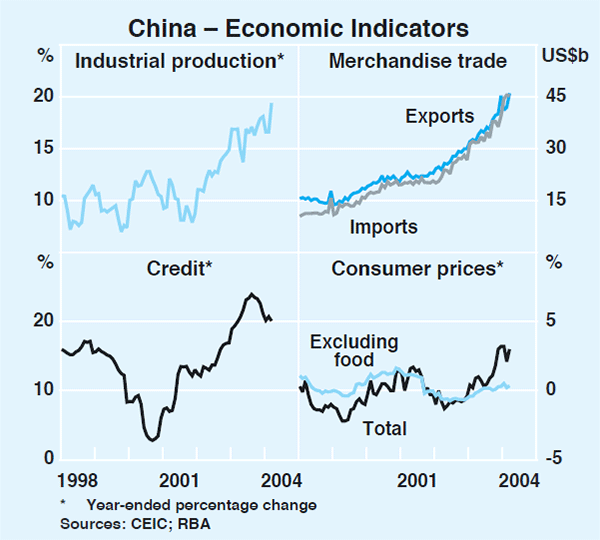
Elsewhere in the region, the strong growth experienced since mid 2003 has continued into 2004. Industrial production and merchandise exports are still expanding rapidly, fuelled by depreciations in real exchange rates, a resurgent world economy and ongoing strength in China, which has boosted intra-Asian trade (Graph 8). Growth in retail sales and investment has also picked up, spurred by stronger stock markets, falling unemployment and more buoyant sentiment. For the moment, consumer price inflation remains contained across the region. However, increased inflation pressures evident in upstream measures are starting to show up at the consumer level in some countries, including Singapore and China.
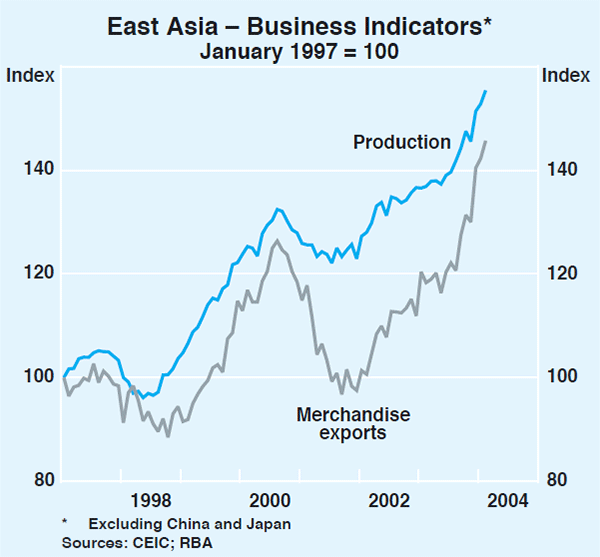
In Korea, soaring exports have been the main driver of growth in the economy. Domestic demand has been held back by weak consumption, which fell by 2.6 per cent over the year to the December quarter in response to restrictive measures introduced in 2002, aimed at slowing the previously very strong rates of growth in consumer credit. Household spending is expected to start to recover soon, now that the strong export-led growth is flowing through to the labour market. The government has also implemented a number of measures to help speed the recovery, such as lowering the sales tax on various luxury goods and frontloading some of its own spending.
The New Zealand economy is growing solidly, propelled by strong growth in domestic demand. GDP expanded by 0.6 per cent in the December quarter, after rising by 1.6 per cent in the September quarter, to be 3.2 per cent higher over the year. Domestic demand was up by 6.8 per cent over the year, with household consumption, residential investment and business investment all growing rapidly. However, net exports subtracted 3.4 percentage points from GDP growth over the same period. The latest retail sales figures and consumer confidence surveys suggest that growth in consumer spending remained firm in the March quarter. Reflecting buoyant domestic demand, non-tradable inflation stood at 5.0 per cent over the year to the March quarter. This was offset by falling import prices resulting from the appreciation of the New Zealand dollar, so total CPI inflation remained low at 1.5 per cent over this period. The Reserve Bank of New Zealand increased the overnight cash rate by 25 basis points to 5.5 per cent in late April, in response to domestic inflation pressures and the strengthening global economy.
Europe
In contrast to the other major economic regions, the euro area is experiencing only the mildest of recoveries. Domestic demand remains weak and the appreciation of the euro appears to be dampening export growth. In the December quarter, GDP expanded by 0.3 per cent to be 0.6 per cent higher over the year (Table 3). Encouragingly, investment rose in the quarter at its fastest rate in three years. However consumption remains weak, being flat in the quarter and rising by 0.6 per cent over the year.
| September quarter |
December quarter |
Year to December |
|
|---|---|---|---|
| Euro area | 0.4 | 0.3 | 0.6 |
| – Germany | 0.2 | 0.2 | 0.0 |
| – France | 0.7 | 0.7 | 1.2 |
| – Italy | 0.4 | 0.0 | 0.1 |
| – Spain | 0.6 | 0.7 | 2.7 |
| – Netherlands | 0.0 | 0.4 | −0.4 |
| United Kingdom | 0.8 | 0.9 | 2.7 |
|
Source: Thomson Financial |
|||
Although business surveys continue to point to a gradual recovery in activity in the euro area, recent trends in the production and spending data have been less encouraging (Graph 9). After improving throughout the second half of last year, business confidence has remained broadly steady in recent months, at levels roughly consistent with trend output growth. However, euro area industrial production has shown few signs of recovery, and has fallen slightly over the past three months. Retail sales data also suggest that consumption remains sluggish, held back by subdued consumer sentiment.
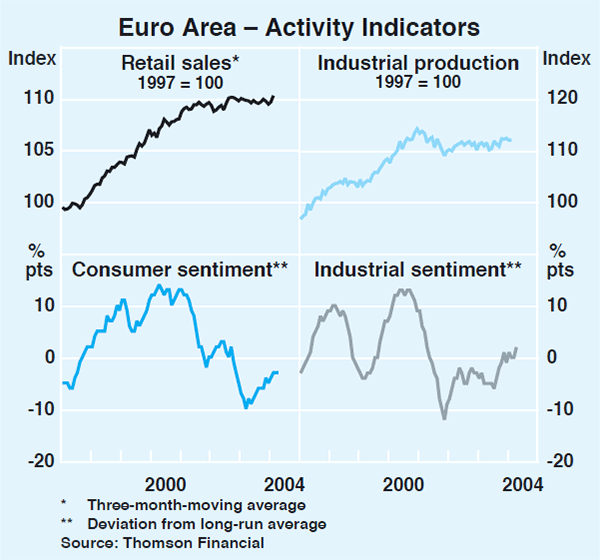
The labour market is showing signs of stabilisation, with the unemployment rate holding steady for the past year at 8.8 per cent. Weak economic conditions in the past couple of years have seen growth in labour costs slow to 2½ per cent over the year to the December quarter, from 3½ per cent a year earlier. Inflation outcomes have been broadly in line with the ECB's target of inflation close to, but less than, 2 per cent. Consumer price inflation has slowed a little, from 2.2 per cent in late 2003 to 2.0 per cent over the year to April, and measures of underlying inflation are generally also around 2 per cent. The ECB has held its policy rate steady at 2 per cent since June 2003.
In the United Kingdom, the economy remains buoyant, spurred by a strong labour market and continued rapid growth in house prices (Graphs 10 and 11). UK GDP rose by 0.6 per cent in the March quarter, to be 3.0 per cent higher than a year earlier. The household sector remains the key driver of growth, with retail sales having risen by 6.4 per cent over the year to March. Unemployment is at its lowest rate since the mid 1970s and the housing market has shown renewed strength in recent months, with year-ended growth in national house prices back above 15 per cent. However, conditions in the business sector are more subdued. Although there has been a noticeable lift in business confidence over the past six months or so, manufacturing production has shown no growth over the past year. Consumer price inflation fell from 1.3 per cent in February to 1.1 per cent in March. The Bank of England left policy rates unchanged in April after the increase in February.
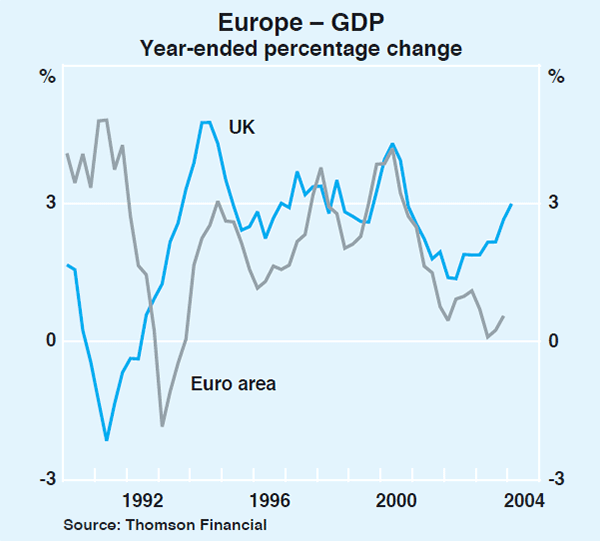
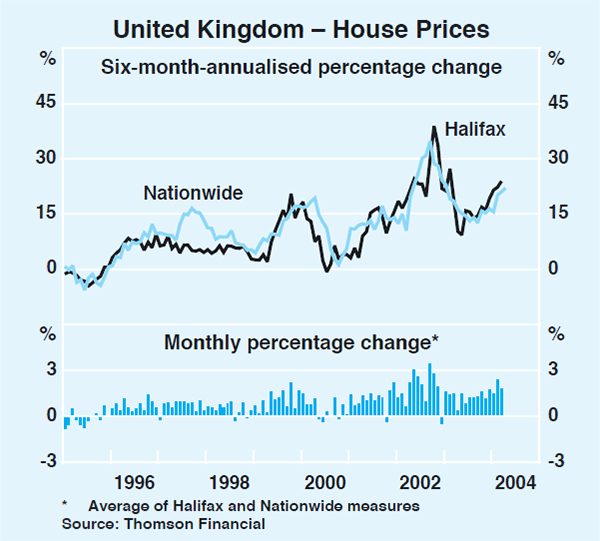
Oil price developments
The West Texas Intermediate crude oil price has tended to increase over recent months, to be around US$38 per barrel, compared with around US$32 in late 2003 (Graph 12). The rise reflects strong global demand for oil, particularly from the US and China, consistent with the pick-up in demand for commodities more generally. Although there has been some rebuilding of crude oil stocks recently, gasoline stocks in the US remain quite low. This has prompted some concern over the adequacy of current supplies in the US and resulted in upward pressure on prices. Developments on the supply side have also contributed to the strength in oil prices over recent months. Political demonstrations in Venezuela, a major oil producer, have led to fears of possible supply disruptions, while OPEC reduced official output quotas by 1 million barrels per day from the beginning of April.
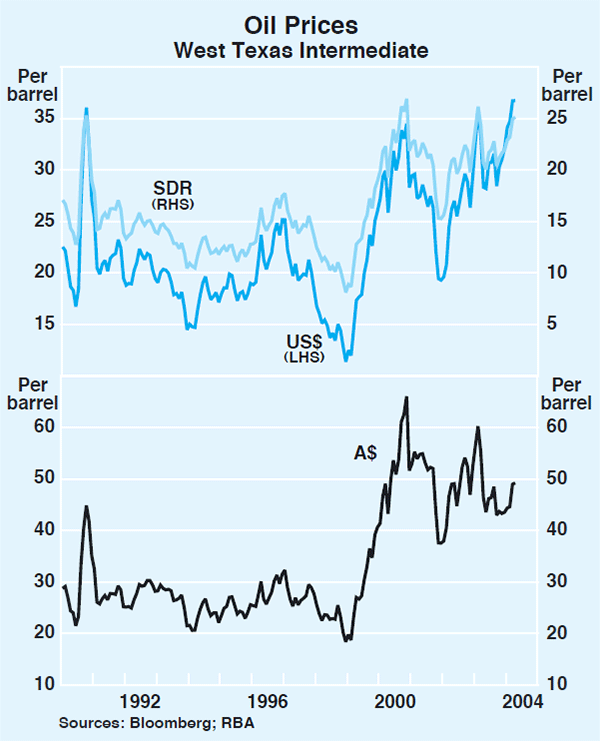
Part of the marked increase in US dollar oil prices over the past year has simply reflected the depreciation of the US dollar. Although the rise in oil prices in SDR terms has been significant, it has been less pronounced. Similarly, oil prices in Australian dollar terms are currently well below the peaks seen in 2000 and 2003.
Box A: The Rise of India
With a population of nearly 1.1 billion, India is the second most populous country in the world, behind China with 1.3 billion people. India's economy has performed strongly in recent years, with GDP growth averaging an impressive 6.1 per cent annually over the past 10 years (Graph A1). While not as rapid as the growth of China in that period, this growth performance has steadily increased India's weight in the global economy. It is now the world's fourth largest economy on a purchasing power parity basis, behind the US, China and Japan, and accounts for some 5.7 per cent of world output. At market exchange rates, India ranks as the 12th largest economy, accounting for 1.6 per cent of world output. Contributing to this performance has been a program of economic liberalisation, including increased openness to foreign trade and investment, financial sector deregulation and a more prominent role for the private sector.
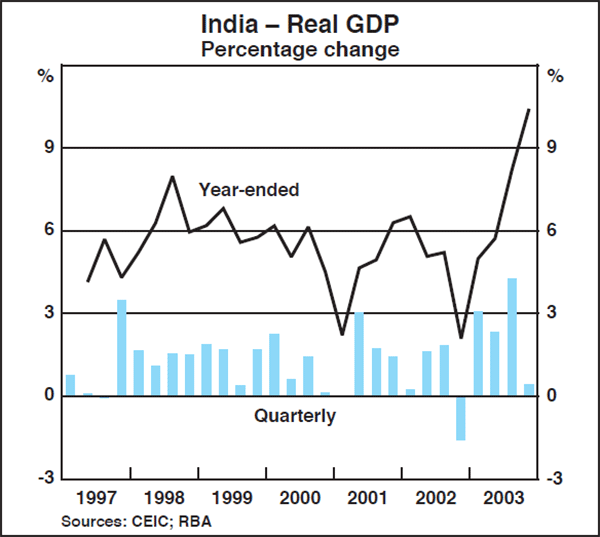
Agriculture accounts for nearly 25 per cent of India's GDP, although this proportion has been declining over time as the services sector and, to a lesser extent, manufacturing have become more important. The industrial sector makes up around 25 per cent of GDP, while services currently account for just over 50 per cent. Most of the labour force, however, still works in the agricultural sector.
International trade accounts for a relatively modest share of economic activity in India. India's openness to trade as measured by the sum of exports and imports as a ratio to GDP was around 30 per cent in 2003. This is well below the median level of openness globally, which was around 75 per cent in 2002. However, this is not surprising given that large economies – in terms of area and population – typically have a very large share of trading activity occurring within national borders. Also, India still has relatively restrictive foreign trade policies compared with international norms, notwithstanding recent reforms in this area. Overall, India accounted for 0.8 per cent of world merchandise trade in 2003, up from 0.6 per cent in 1990, leaving it outside the top 20 trading nations. This compares with China's current rank as the third largest trading nation in the world, accounting for around 6 per cent of world merchandise trade.
Nonetheless, India's trade has been increasing rapidly, growing at an average annual rate in real terms of around 13 per cent over the past 10 years – twice the rate of overall world trade. India's largest trading partners are the euro area and the US. However, trade with Asia (particularly China) has been growing very rapidly in recent years. Although India runs a merchandise trade deficit (2½ per cent of GDP in 2002/03), it has a modest surplus on the current account (0.8 per cent of GDP in 2002/03), owing to sizeable inward current transfers and a surplus for net services. In real terms service exports have been growing at an average annual rate of close to 20 per cent over the past 10 years. Software and information technology services have been key drivers of this growth, and make up almost half of India's service exports.
India accounted for 2.2 per cent of Australian merchandise exports in 2002/03, making it Australia's 11th largest export market. Australia exports mostly resources to India, including coking coal and metal ores. More recently, India has also become a much more important destination for Australian gold exports. Exports of gold are largely responsible for the sharp increase in resource exports to India over the past year, although this has been at the expense of alternative markets such as in east Asia and the EU, as Australia's total gold exports have not increased significantly over this period. Excluding gold, growth in resource exports to India has been much more subdued (Graph A2).
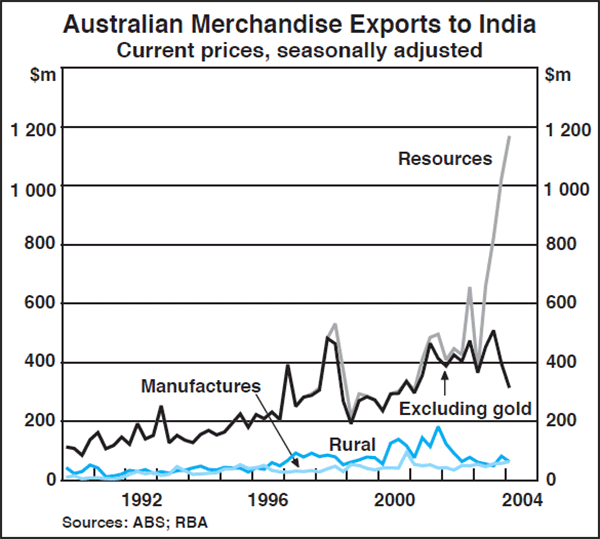
In contrast to exports, India accounts for only a small share of Australian merchandise imports, at around 0.7 per cent in 2002/03. Australia imports mainly manufactured items from India, with the most important items by value being textiles and clothing, machinery and non-metallic minerals.
International and Foreign Exchange Markets
Money and bond yields
With the global economic recovery consolidating over the past three months, the main focus of markets has been on the likely timing of the first increase in the US federal funds rate from its 45-year low of 1 per cent. These expectations have been driven largely by fluctuations in US labour market data. Weaker-than-expected non-farm payrolls releases for January and February saw expectations of monetary tightening pushed out to the end of 2004. This was subsequently reversed in early April, on the release of a strong non-farm payrolls outcome for March. The federal funds futures market currently expects the FOMC to increase rates by 25 basis points by August at the latest (Graph 13).
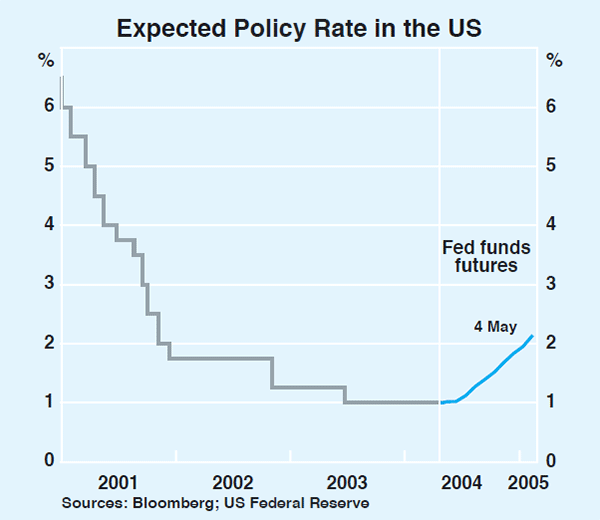
The pace of tightening currently priced in by the market is very moderate compared with the experience in past tightening cycles. The market expects a tightening of 75 basis points by year end, and the yield curve indicates that the implied cash rate in a couple of years' time will still be under 4 per cent. That would be a relatively low level by historical standards; in the past two tightening cycles by the Fed, the federal funds rate peaked at around 6 per cent.
In Europe and Japan, markets do not expect the monetary authorities to tighten in the foreseeable future; in fact in Europe there is still talk of an interest rate cut as the economic recovery has continued to lag the rest of the world. In Japan, while the economic recovery is broadening, the Bank of Japan has indicated that it will maintain highly stimulative policy until inflation becomes consistently positive.
The direction of monetary policy in other developed economies has continued to diverge (Graph 14, Table 4). The Bank of Canada has cut its policy rate by a cumulative 75 basis points so far this year (in three moves) to 2 per cent, against a background of weak GDP growth and subdued inflation. Similarly, the Swedish Riksbank has cut its policy rate by a total of 75 basis points (in two steps) to 2 per cent, in the face of a larger-than-expected fall in inflation. In contrast, the Bank of England increased its repo rate by 25 basis points in February to 4 per cent, following a similar move in November, while the Reserve Bank of New Zealand has increased its policy rate by 50 basis points so far this year (in two steps) to 5.5 per cent. The range of policy interest rates among industrial countries remains unusually wide.
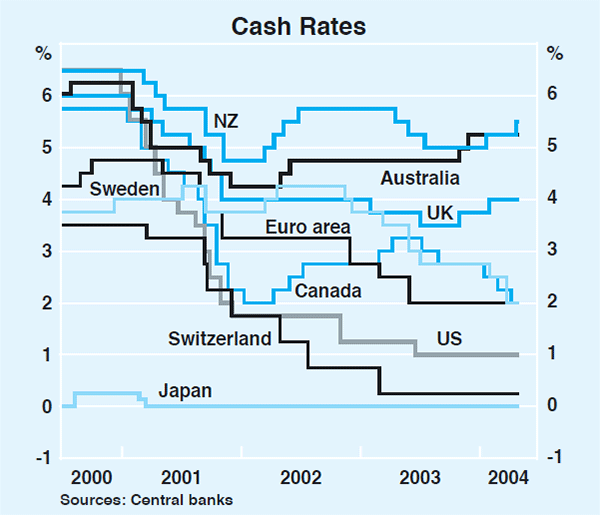
| Cumulative reductions in down cycle Basis points |
Changes in policy rates (basis points) | Current level Per cent | ||
|---|---|---|---|---|
| From low point |
Since Jan 2004 |
|||
| US | −550 | – | – | 1.00 |
| Canada | −375 | – | −75 | 2.00 |
| Switzerland | −325 | – | – | 0.25 |
| Euro area | −275 | – | – | 2.00 |
| UK | −250 | 50 | +25 | 4.00 |
| Sweden | −225 | – | −75 | 2.00 |
| Australia | −200 | 100 | – | 5.25 |
| NZ | −175 | 50 | +50 | 5.50 |
| Japan | −25 | – | – | 0.00 |
|
Sources: Central banks |
||||
Despite very strong economic growth over recent quarters, most Asian central banks have maintained highly accommodative monetary policy settings over the past three months. Indonesia reduced its official rate by a total of 75 basis points to 7 per cent in response to further declines in inflation. The People's Bank of China, however, announced a further increase in reserve requirements for banks in an effort to ameliorate overheating in some sectors. The Monetary Authority of Singapore (MAS) also signalled a tightening of monetary conditions when it announced in April that it will allow a ‘modest and gradual’ appreciation of the Singapore dollar. The MAS cited a more favourable growth outlook and the risk of rising inflationary pressures as reasons for the change.
Amongst other emerging market economies, the only significant policy moves were in Brazil, where rates were cut by a further 50 basis points to 16 per cent, and Turkey, which cut rates by a total of 4 percentage points, to 22 per cent.
Over the past three months, yields on both US and European government bonds have been driven largely by expectations about the timing of the prospective start of the normalisation of US monetary policy (Graph 15). Yields in both regions fell sharply following the release of disappointing US employment data early in the year, reaching their lowest levels since mid 2003. However, as expectations of the next tightening in the US were moved forward following the March payrolls release in early April, yields rose sharply. In the case of the US, yields rose by 90 basis points from their March low point, to reach 4.6 per cent – at the upper end of their range over the past year. German yields rose 30 basis points to around 4.2 per cent, a little lower than three months earlier.
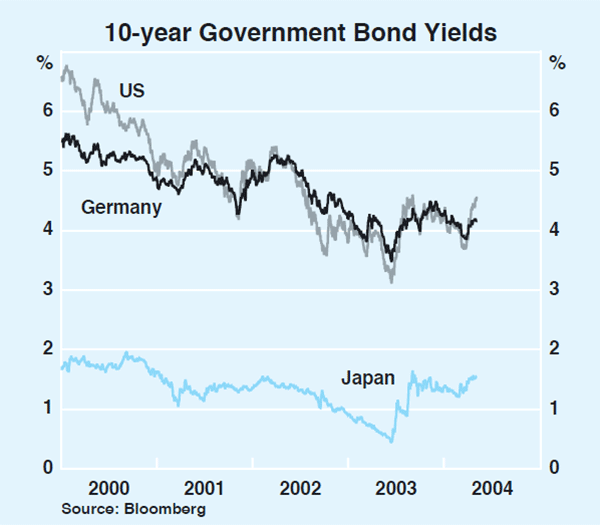
The continuing flow of solid economic data in Japan, and more upbeat assessments of the economy by Japanese officials, strengthened hopes that the current upturn will be sustained. This saw yields on Japanese government debt rise steadily in March and April to around 1.5 per cent, 30 basis points above their mid-February low. Consistent with the better economic outlook for Japan, Moody's upgraded Japan's long-term foreign currency debt rating in early April and S&P upgraded the outlook on Japan's domestic currency sovereign credit rating in late March.
The increasingly positive outlook for the global economy and the associated reduction in risk aversion have continued to help corporate and emerging market sovereign debt. US corporate spreads narrowed modestly over the three months since the last Statement, from levels already well below historical averages (Graph 16).
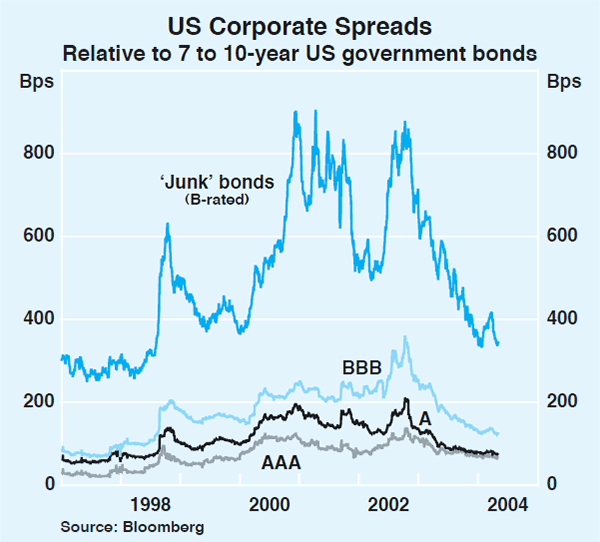
The fall in spreads has been accompanied by a sharp reduction in differentiation between high and low rated credit risks (Graph 17). Spreads on the lowest quality segment of the ‘junk’ bond category, ‘C’ rated bonds, have narrowed by an extraordinary 30 percentage points since late 2001, to around 5.5 percentage points. These bonds have a very high default rate (historically greater than 25 per cent). This indicates that investors are becoming much less discerning in their investments as they seek out yield.
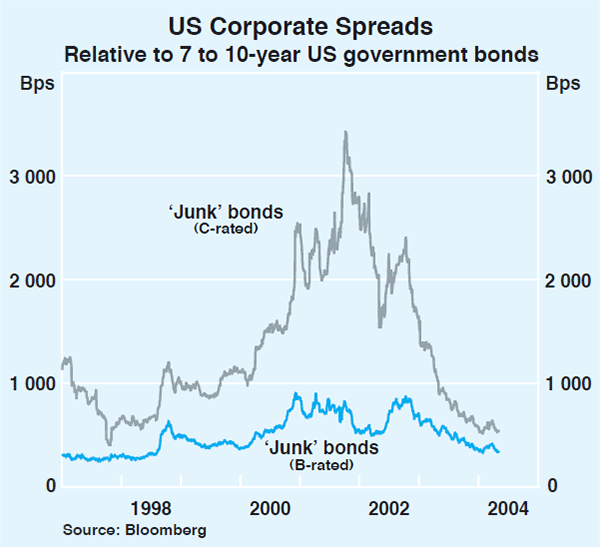
Spreads on emerging market sovereign debt rose modestly over the past three months, to an average of around 310 basis points over US Treasuries (Graph 18). However, they remain close to the low level prevailing before the Asian crisis, reflecting the generally benign environment for most emerging markets as well as investor appetite for higher yields than currently prevail in industrial countries.
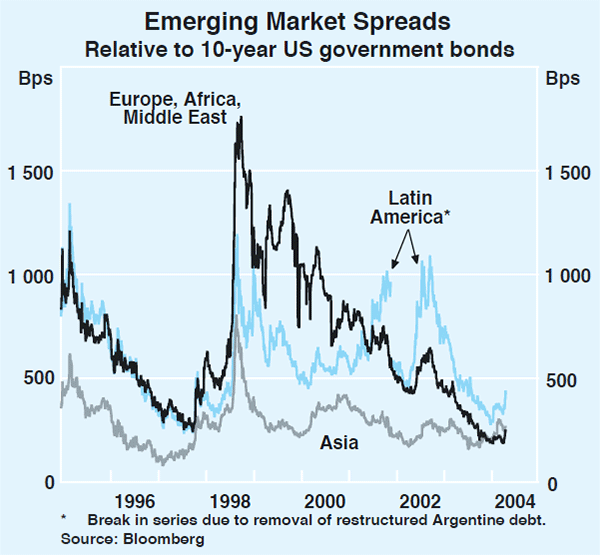
Equity markets
After rallying strongly in the 12 months to February, the major US and European equity indices traded broadly sideways over the past three months as investors focused on the likelihood that US interest rates will rise sometime this year (Graph 19, Table 5).
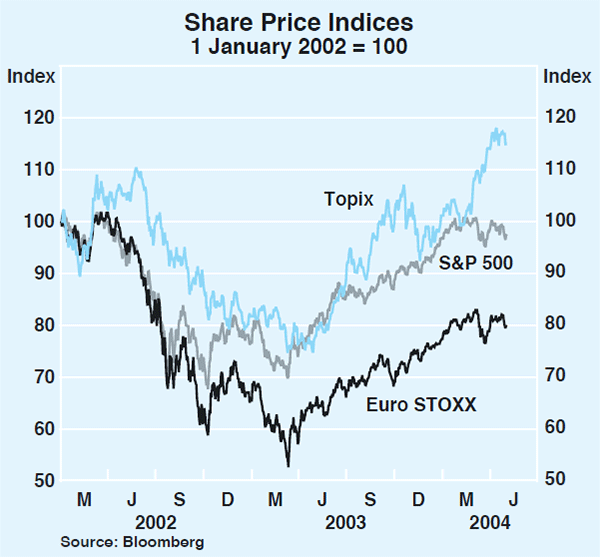
| 2004 to date |
Change since 2000 peak |
Change since 2003 trough |
|
|---|---|---|---|
| United States | |||
| – Dow Jones | −1 | −12 | 37 |
| – S&P 500 | 1 | −27 | 40 |
| – NASDAQ | −3 | −61 | 53 |
| Euro area | |||
| – STOXX | 3 | −46 | 52 |
| United Kingdom | |||
| – FTSE | 2 | −34 | 38 |
| Japan | |||
| – TOPIX | 14 | −32 | 54 |
| Canada | |||
| – TSE 300 | 3 | −26 | 36 |
|
Source: Bloomberg |
|||
In the US, the S&P 500 has fallen 1 per cent since the beginning of February, although it remains 40 per cent above its March 2003 trough. The rally stalled despite the rapid rebound in corporate profitability (Graph 20), perhaps reflecting some concern in markets about the likelihood of a monetary tightening in the US. The strong rise in company profits, coupled with changes to corporate taxation and depreciation rates, has seen the profit share of GDP (after tax and depreciation) touch historical highs (Graph 21). As a result, the S&P 500's price/earnings ratio has fallen to its lowest level since 1997 – although it remains well above its long-term average (Graph 22).
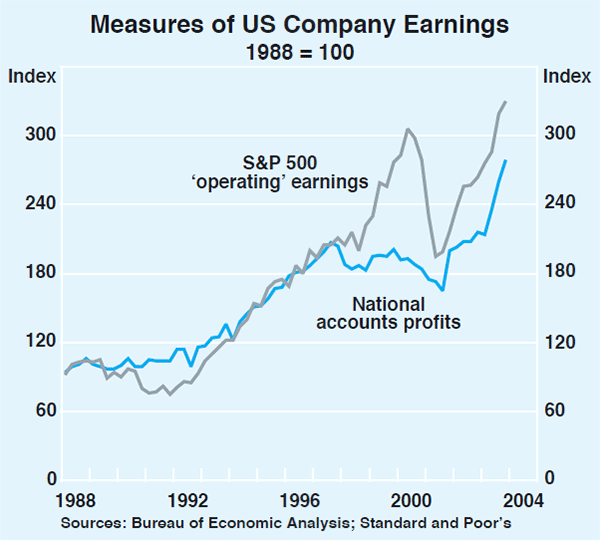
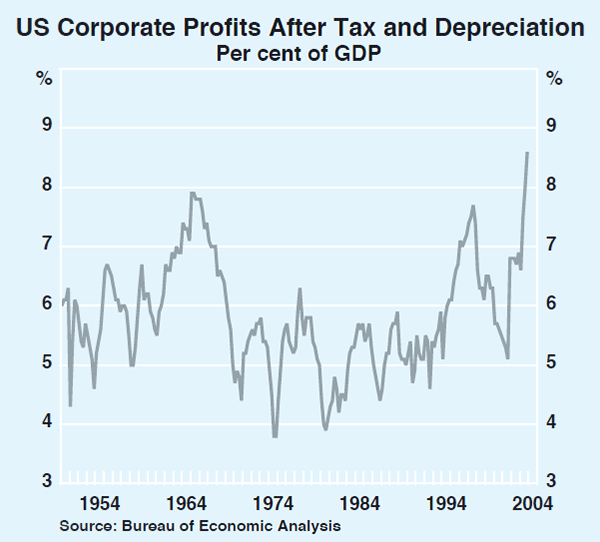
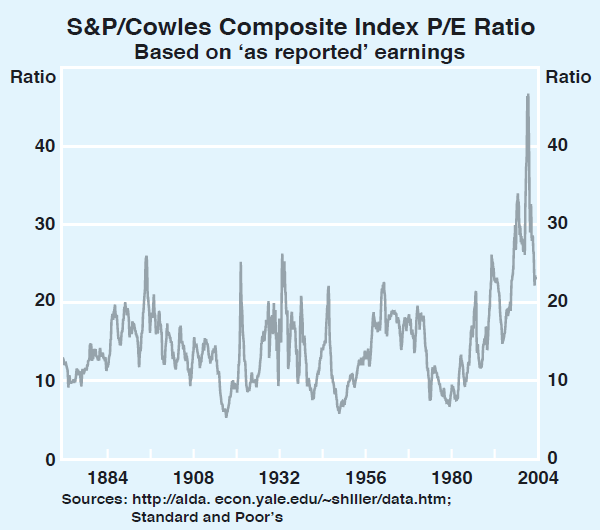
The major European equity markets have continued to take their lead from the US, despite the more subdued nature of the economic recovery in the euro zone. The Euro STOXX is up only marginally over the past three months, but remains 52 per cent above its March 2003 low.
While the rally in the major US and European indices stalled over the past three months, Japanese share prices continued to surge, reflecting increasing confidence that the economic recovery is self-sustaining. The Topix index has increased 13 per cent since the beginning of February and is now 54 per cent above its March 2003 low point. The rally has been led by the banking sector, which has risen by 34 per cent since February. Reflecting the sector's improved prospects, Moody's upgraded the ratings outlook for four Japanese banks in mid March.
Other Asian equity markets have on average fallen modestly in recent months, led by falls in the Hong Kong market, where currency board arrangements mean that interest rates are expected to rise as the US Fed starts to tighten. Latin American equity markets have also been relatively subdued.
Exchange rates
After falling for the previous two years, the exchange rate of the US dollar in trade-weighted terms appreciated modestly over the past three months. The broad trade-weighted index (TWI) has risen by around 2 per cent, while the major currencies TWI is up by around 4 per cent (Graph 23). Greater confidence in the US economic recovery and the belief that interest rates in the US may begin to rise sooner than had been thought a couple of months ago have helped to lift the US dollar.
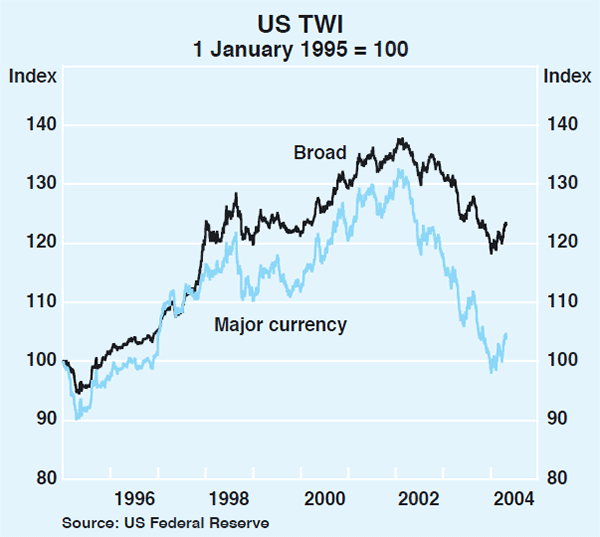
After reaching a record high against the US dollar of US$1.293 in mid February, the euro depreciated over subsequent months and is now about 6 per cent below its mid-February peak (Graph 24). On a trade-weighted basis, the euro has fallen by about 3 per cent since mid February.

The yen has been volatile over the past three months, in net terms falling by 3 per cent against the US dollar. Heavy official intervention initially pushed the yen down in February and March; intervention in the March quarter was US$140 billion, a record quarterly amount and followed intervention of US$175 billion in 2003. From mid March, as intervention was wound back, the yen rose for a time but it could not sustain the upward momentum in April in the face of the broad-based rise of the US dollar following the stronger-than-expected US economic data.
Currencies of other Asian and Latin American countries were, on average, broadly flat against the US dollar. In the case of Asian currencies, this in part reflected ongoing foreign exchange intervention. Official reserves of Asian countries (excluding Japan) rose by around US$50 billion over February and March.
Australian dollar
After peaking at US80 cents in mid February, the Australian dollar fell through the second half of February and early March. Following a temporary recovery to US77 cents in mid April it fell again, reaching a low of US71.24 cents. The decline has been the first major fall since mid 2003, with the Australian dollar currently about 9 per cent below its peak (Graph 25).
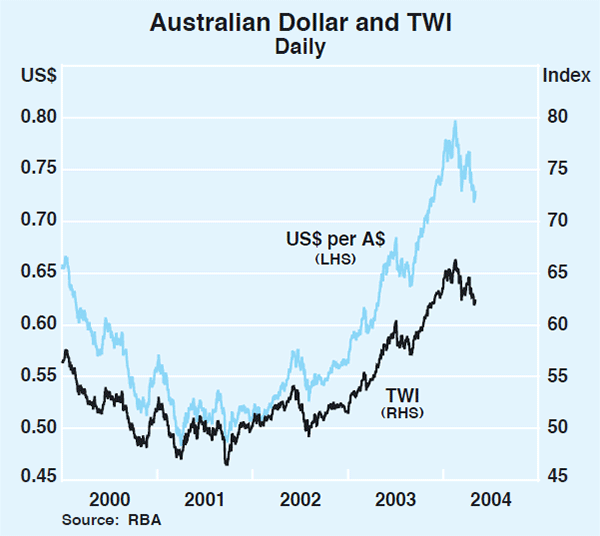
Some of the fall in the Australian dollar over recent months has been a reflection of the strengthening US dollar. Other factors have also been at work, however, as the Australian dollar has fallen against all currencies in the TWI except the New Zealand dollar – i.e. the fall has been very broadly based (Table 6).
| Over past year |
Since 18 Feb 2004 peak |
|
|---|---|---|
| Philippine peso | 22.9 | −9.2 |
| US dollar | 15.5 | −8.9 |
| Taiwan dollar | 10.4 | −8.1 |
| Singapore dollar | 10.8 | −7.5 |
| South Korean won | 11.5 | −7.3 |
| Japanese yen | 6.3 | −5.2 |
| Indonesian rupiah | 16.7 | −4.9 |
| Canadian dollar | 11.5 | −4.3 |
| Swiss franc | 9.9 | −4.3 |
| South African rand | 6.7 | −3.5 |
| Swedish krona | 7.8 | −3.1 |
| European euro | 7.0 | −2.8 |
| UK pound | 3.1 | −2.8 |
| New Zealand dollar | 3.0 | 2.1 |
|
Source: RBA |
||
Recent weakness in the Australian dollar may have reflected the fact that the market had become over-extended as the exchange rate had risen for six months in a row, with a cumulative rise of 25 per cent. Such a prolonged and large movement, without some correction, is very unusual. An indication of the buying pressure from foreign investors in the Australian dollar market over late 2003/early 2004 can be seen in Graph 26 which shows positions in the Australian dollar futures contract on the Chicago Futures Exchange. Long positions had built up to record levels by early 2004. These have since largely been unwound, indicating that the market has become more balanced recently.
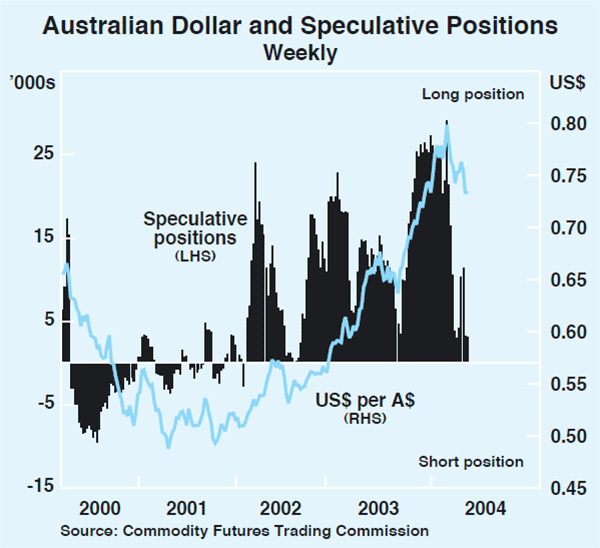
A pattern that has emerged over the past couple of years has been for the Australian dollar to move more overnight in offshore trading sessions than in domestic sessions (Graph 27). There may be two reasons for this. First, the moves in the exchange rate to a large degree have been a reflection of moves in the US dollar on world markets, which in turn reflected news about the US released during the US time zone. Second, foreign investors have been very important participants in the Australian dollar market and a lot of their trading has taken place during their day in Europe and the US. Around 95 per cent of the appreciation in the currency from its lows in April 2001 has occurred in overnight trading. Weakness in the Australian dollar observed in recent months has notably also occurred in the overnight trading session, again reflecting the importance of offshore players.
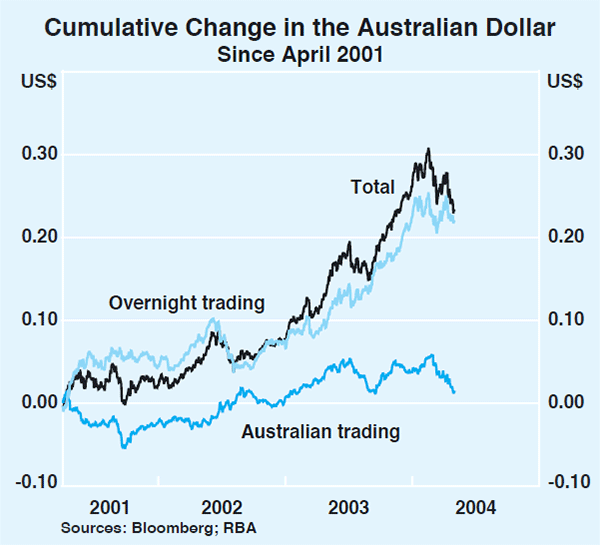
There is evidence to suggest that export companies have increased their hedging in early 2004 after scaling it back in 2003. Mining companies in particular appear to have increased their hedging significantly, with the proportion of their net currency exposure hedged increasing to 35 per cent over the March quarter, from 20 per cent late last year. The average term of hedges is about 20 months.
With the exchange rate somewhat weaker in recent months, the Bank curtailed its replenishment of foreign exchange reserves. Over the past three months its net purchases of foreign exchange amounted to $1.8 billion, most of which occurred prior to the peak in the Australian dollar in mid February. In the previous three months the Bank had been more active, accruing $5.8 billion in reserves. As at the end of April, net reserve assets were $23 billion. The Bank also held a further $25.6 billion under foreign exchange swaps, a slight increase over the past three months as swaps have continued to be used for domestic liquidity management.
Domestic Economic Conditions
Introduction
The Australian economy grew rapidly over the second half of 2003, with output expanding at an annualised rate of 5½ per cent. While growth should moderate from this rapid pace in 2004, early indications are that it will still be relatively strong. In the December quarter, GDP increased by 1.4 per cent, to be 4.0 per cent higher over the year (Graph 28). There was a continuation of the rapid expansion in domestic spending that has been underway since late 2001, with domestic final demand rising by 2¼ per cent in the quarter, almost double the average pace of the previous 10 years. The strength in domestic demand was broadly based, but the rise in consumer spending was particularly notable and resulted in the highest year-ended rate of growth in consumption in nearly five years. In addition, a further sharp rise in farm output contributed 0.4 percentage points to quarterly GDP growth.

Despite a pick-up in exports, net trade remained a substantial drag on GDP growth in the December quarter owing to rapid growth in import demand, driven by strong domestic demand and the appreciation of the exchange rate. Recent trade figures point to continued solid growth in exports in early 2004, in line with the improving international environment and much-improved rural conditions.
Household sector
The growth of household spending was very rapid in late 2003. Growth appears to have continued into 2004, albeit at a more moderate pace. National accounts data show that growth in real household consumption in the second half of 2003 was 7 per cent on an annualised basis, the strongest pace in over 20 years. Growth has been supported by further strong rises in wealth, particularly from the gains in property prices over recent years. There was also a noticeable acceleration in disposable income in the second half of 2003, following a year of relatively weak growth (Graph 29). This was underpinned by an improvement in farm income and a pick-up in income from dividends and interest. The strength of employment and real wages has also played a role in boosting household incomes and this is expected to continue through 2004.
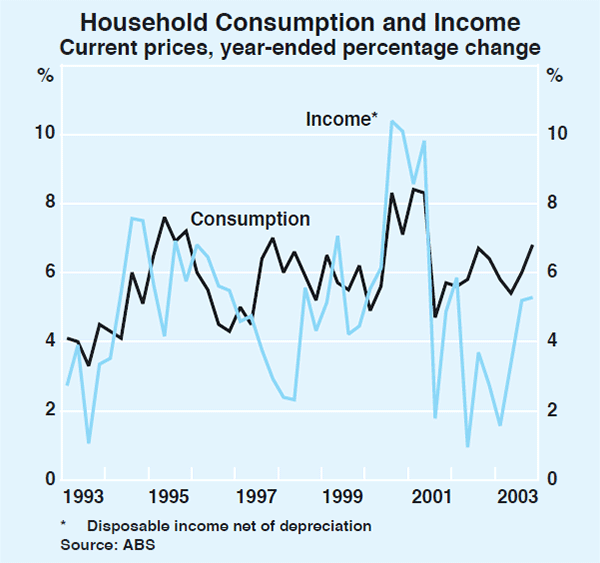
More recent data on retail sales, which account for more than one-third of household consumption, point to slower growth in consumption in the March quarter. The value of retail sales rose only modestly in the first two months of the year, following exceptionally fast growth at the end of 2003. Concurrently, however, growth of prices appears to have been quite subdued, suggesting some growth in real terms. Available data point to strong growth in other components of household consumption. Sales of motor vehicles rose strongly in the March quarter to be 9 per cent higher over the year; this growth follows a record level of sales in 2003 (Graph 30). Buoyant demand in this market stems from the high level of vehicle affordability – in part a consequence of the appreciation of the Australian dollar – and generally favourable financial conditions. More broadly, consumer sentiment remains at a high level, especially with regard to employment prospects.
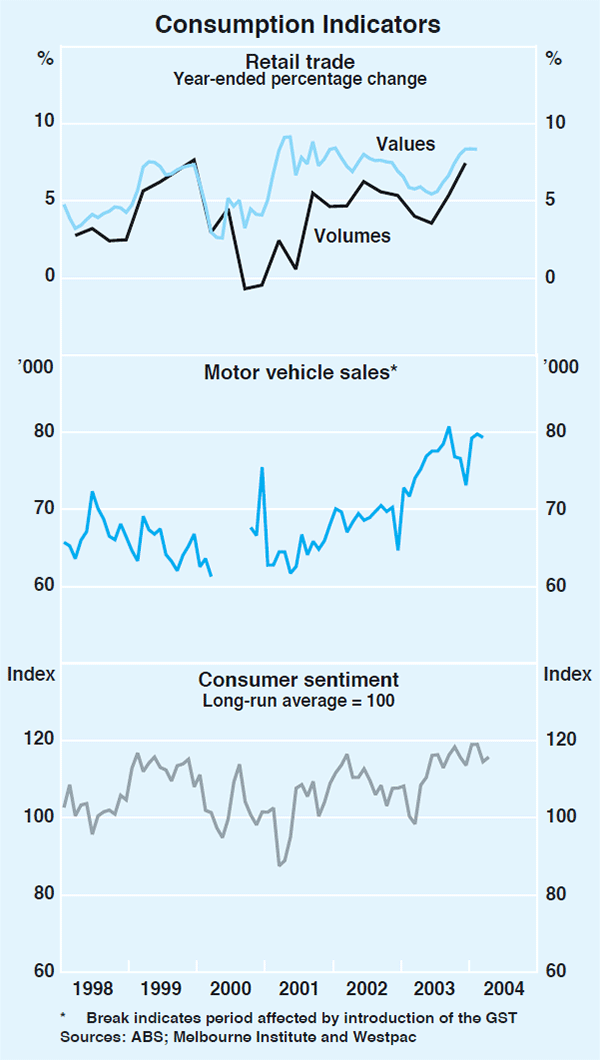
Although the growth rate of household income picked up in the second half of 2003, it was still lower than that of consumption (Graph 29). This has resulted in a further fall in the saving ratio, which appears to have been related to the substantial rise in the value of household assets over the past year. Asset values have been boosted by growth in house prices, and to a lesser extent by the recent improvement in equity markets. At the same time, households have continued to accumulate debt at a rapid pace, with credit extended to households increasing by 22 per cent over the year to March. The ongoing growth in debt has seen a steady increase in interest payments as a proportion of disposable income, and at the end of 2003 this measure of the debt-servicing burden exceeded its previous peak in the late 1980s (Graph 31). However, in contrast to the late 1980s, consumer sentiment remains at a high level. In addition, indicators of financial stress – such as loan arrears – remain low, suggesting that the high debt-servicing burden is not yet imposing a significant constraint on consumer spending.
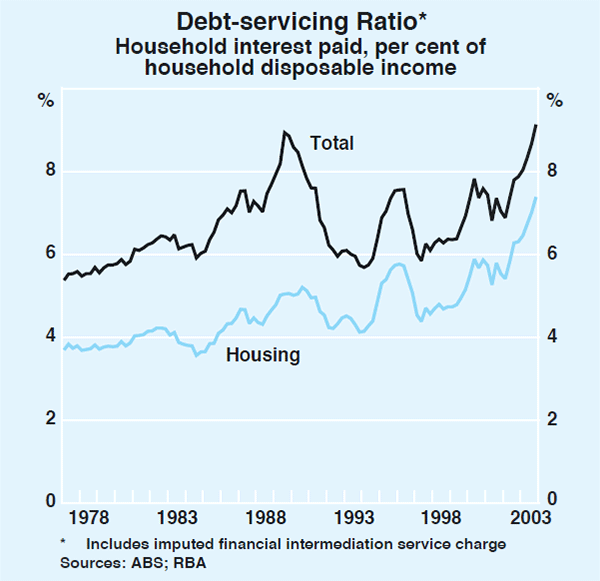
Housing
Activity
Dwelling investment grew strongly over the second half of 2003, with a 3.3 per cent increase in the December quarter, taking the share of dwelling investment in GDP close to record levels. Growth at the end of 2003 was concentrated in new dwelling construction, with renovation activity making only a modest contribution to growth.
Private residential building approvals – a leading indicator of activity – have trended down over recent months, so that in March the number of approvals was 17 per cent below the peak observed in September 2003. This decline reflects weakness in both house and medium-density approvals (Graph 32). Looking ahead, further falls in approvals seem likely. The Housing Industry Association reports that commitments to build houses are now around 35 per cent below their recent peak, and that new multi-unit sales continue to trend down. Nevertheless, commencements and work yet to be done were still at high levels in the December quarter, with builders of houses reporting large backlogs of work and many apartments remaining committed for construction. Activity is thus likely to have held up at a relatively high level in the early part of 2004, but is expected to decline thereafter. Even so, a number of factors suggest that the decline will be mild in comparison with previous housing cycles. In particular, strong underlying demand for housing and generally positive macroeconomic conditions are likely to sustain new dwelling construction. Also, declines in new dwelling construction are likely to be partially offset by relative strength in renovation activity.
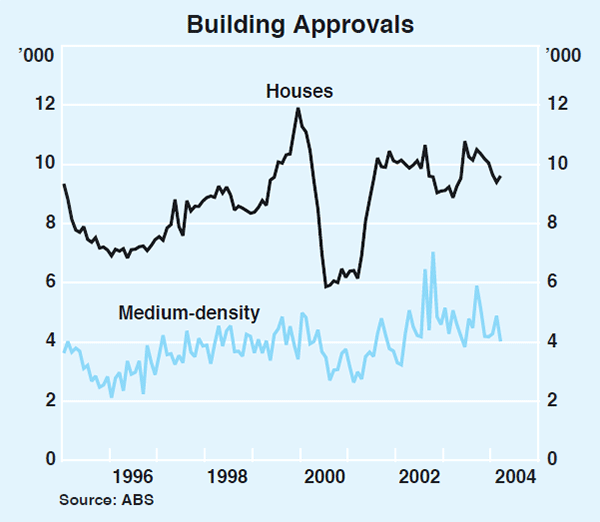
Financing and prices
The value of housing loan approvals peaked at around $15 billion a month in October 2003 and has now fallen in each of the four months to February, to an amount currently around $12 billion a month. As was explained in ‘Box C’ in the February 2004 Statement, the level of loan approvals is a leading indicator of the growth rate of credit, though the relationship from month to month is not very precise. There are some tentative signs that the decline in loan approvals is starting to reduce credit growth, with the rate of growth of housing credit having eased modestly on a three-month-ended basis in recent months but not on the widely used twelve-month-ended basis (Graph 33). However, both loan approvals and credit growth still remain at high levels, and the value of loan approvals would need to fall significantly further to bring credit growth back to a reasonably sustainable pace.

Consistent with the easing in finance approvals, there have been a number of signs of a cooling in the housing market since the end of last year. After the rapid increases recorded during 2003, available data for the early part of 2004 show that house prices have fallen, though the data are volatile and need to be interpreted with caution. The three widely used measures of house prices in Australia are those provided by the Commonwealth Bank of Australia (CBA), the Real Estate Institute of Australia (REIA) and the Australian Bureau of Statistics (ABS). Of these, only the CBA measure is available Australia-wide for the March quarter 2004, and it shows falls in prices for all capital cities (Table 7). The fall in the March quarter follows a surprisingly strong rise in the December quarter, and these movements may partly reflect seasonal changes in the composition of transactions in this period. The housing price data from the REIA are released on a state-by-state basis, and so far only the figures for Melbourne are available for the March quarter. They show a fall in house prices of 0.8 per cent and in apartment prices of 2.1 per cent.
| CBA | APM(a) | Residex(a) | |
|---|---|---|---|
| Sydney | −2.9 | −10.5 | −0.6 |
| Melbourne | −5.0 | −14.5 | 0.0 |
| Brisbane | −2.0 | −0.7 | −0.5 |
| Adelaide | −1.8 | 2.7 | – |
| Perth | −0.5 | −1.0 | – |
| Canberra | −10.7 | −0.6 | – |
| Hobart | −9.1 | – | – |
| Australia | −3.2 | −8.4 | – |
|
(a) Preliminary estimates Sources: Australian Property Monitors; CBA; Residex |
|||
These widely used measures of house prices are all less than fully satisfactory in that the quarterly movements are influenced by compositional changes and contain significant lags in recording transactions; the lags arise because most standard indices record prices as at the date a transaction is settled, which is well after the price was determined by agreement on a contract. In analysing property market developments, the RBA has attempted to overcome these problems by using more specialised indices constructed by property research firms. The series from Australian Property Monitors (APM) deals with the problem of lags by recording prices as at the date of contract. This means that the March quarter data include only transactions that were contracted in the March quarter and have already been settled. Like the other indices cited above, this series shows price falls for all capital cities excluding Adelaide (Table 7). The series shown are the first estimates for the March quarter, which are based on a sample that is a little over a third of the likely total. This will be subject to progressive revision as the full set of transactions becomes available.
A further series from Residex, which has been reported in previous issues of this Statement, deals with the problem of compositional change by using a repeat sales index. It is available for the three largest cities, and in the March quarter shows small falls in Sydney and Brisbane and a flat outcome for Melbourne. These figures are also subject to revision in light of subsequent data. Overall, while no single indicator can be regarded as definitive, the preponderance of price falls in the major cities suggests that for Australia overall, house prices declined in the March quarter.
The above discussion focused on house prices, but the equivalent data are also available for apartments (Table 8). These show significant falls in Sydney and Melbourne for all three indices, but rises in other capital cities (with the exception of Perth, which appears to be an aberration). For Australia overall, the declines in Sydney and Melbourne outweigh the rises elsewhere, implying a substantial fall in prices nation-wide.
| CBA | APM(a) | Residex(a) | |
|---|---|---|---|
| Sydney | −5.4 | −3.5 | −1.6 |
| Melbourne | −10.2 | −10.2 | −1.3 |
| Brisbane | 7.9 | 6.3 | 4.0 |
| Adelaide | 2.0 | 3.2 | – |
| Perth | −23.0 | 3.8 | – |
| Canberra | – | – | – |
| Hobart | – | – | – |
| Australia | −6.6 | −3.3 | – |
|
(a) Preliminary estimates Sources: Australian Property Monitors; CBA; Residex |
|||
A further sign of slowing demand in the housing market since late 2003 is evident in the fall in auction clearance rates across the capital cities. This is especially apparent in Sydney and Melbourne, where clearance rates since November have been well below levels recorded in corresponding periods of previous years. In recent weeks, clearance rates have declined further in Sydney while remaining in the 50–60 per cent range in Melbourne (Graph 34). Survey indicators also imply that buyer sentiment has fallen recently. According to the Westpac-Melbourne Institute survey of consumers, sentiment towards buying a dwelling remained relatively weak in March, though it ticked up slightly from a low in December. The proportion of survey respondents nominating real estate as the wisest place for savings also remains relatively low.
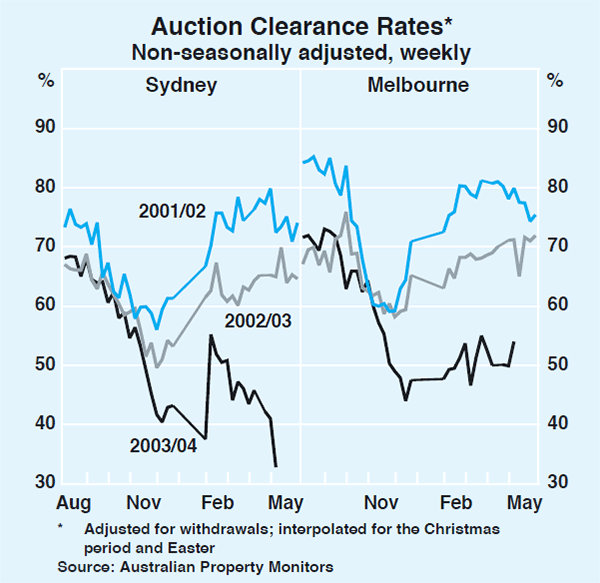
Differences between housing markets across the capital cities are apparent from data on rental markets. Rents continue to grow solidly in Adelaide, Brisbane and Canberra, though they remain generally subdued in other capitals. In Sydney and Melbourne, rental growth is being constrained by high vacancy rates relative to levels of the past. Vacancies for apartments in inner Melbourne and Sydney have stabilised at a relatively high level, and vacancy rates for newly completed apartments have increased sharply in recent months. Reflecting this, apartment rents in inner-city areas have been roughly flat in Sydney over the past year and are well down on earlier peaks in Melbourne (Graph 35).
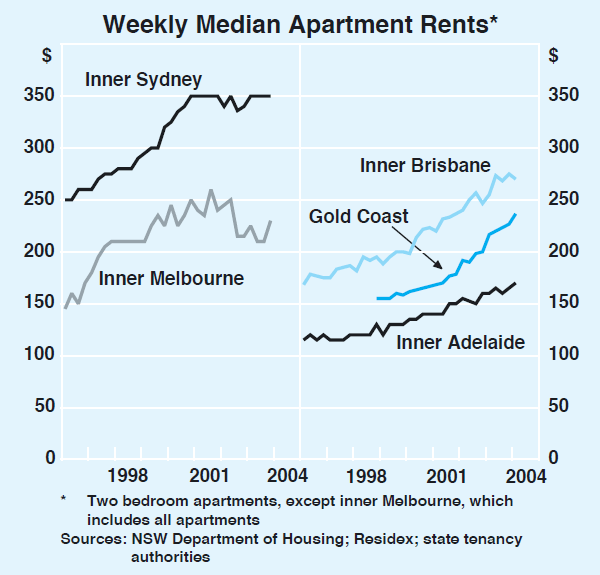
Looking ahead, there are a number of recent developments that could have significant effects on the housing market. One is the announcement by the Australian Tax Office regarding the tightening of depreciation allowances for investment properties. Another is the package of changes to property taxes in New South Wales announced in April. The removal of stamp duty for first-home buyers may provide some boost to this segment of the market. However, the vendor transfer duty on investor property sales and other changes in land tax arrangements are expected to dampen investor demand. In Victoria, reductions in land taxes have been announced for businesses and investors, while first-home buyers will receive a one-off additional grant for purchases before the end of June 2005. All of these changes come at a time of waning sentiment in the investor market, and some recent reports by developers of investors failing to settle on off-the-plan apartments. In light of problems in this segment of the market, greater attention is being paid to some of the legal aspects underlying off-the-plan transactions.
Business sector
Business conditions appear to have eased in early 2004 from the high levels reported at the end of 2003, although they remain consistent with firm growth in non-farm GDP. In particular, indicators of business confidence remain above long-run levels, overall profitability remains strong, and business investment is expected to continue to grow, albeit more slowly than in the past two years.
After a few years of divergent outcomes, robust growth was recorded in both the goods and services sectors of the economy in the second half of 2003 (Graph 36). Farm output also increased rapidly, with the sector recovering from the effects of drought. In the non-farm economy, output growth has generally been strongest in those industries with relatively more exposure to domestic demand, including construction and wholesale and retail trade, as well as various business service industries (Graph 37). Output of tourism-related services has also been strong. In contrast, growth has been much weaker in some other sectors with significant exposure to international markets, especially in manufacturing, where production has been flat over the year owing in part to the effect of the appreciation of the currency. In addition, output in the mining sector has been held back by recent temporary disruptions to production.
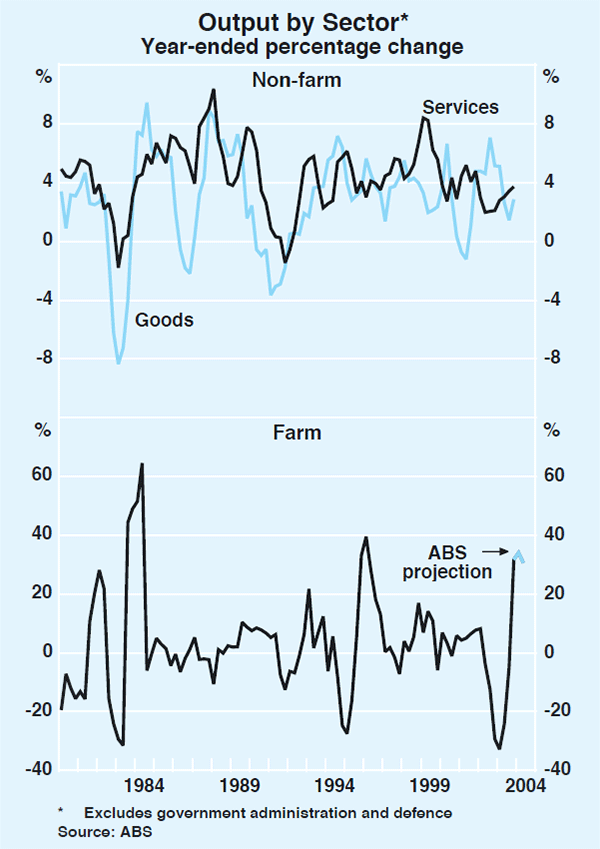
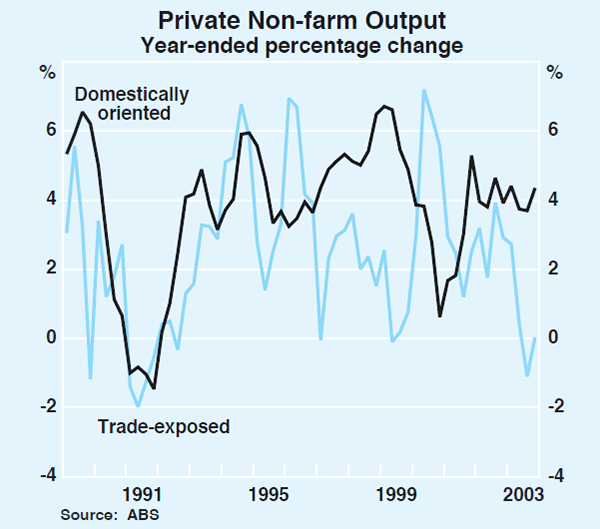
More recent indicators, such as the NAB survey of the non-farm sector for the March quarter, point to a moderate easing in business conditions from the high level in late 2003 (Graph 38). The easing has occurred across most sectors, but was more pronounced for property & business services and the export-oriented areas of mining and agribusiness. However, conditions remain above long-run average levels for all sectors, and are especially favourable for firms with greater exposure to domestic demand.
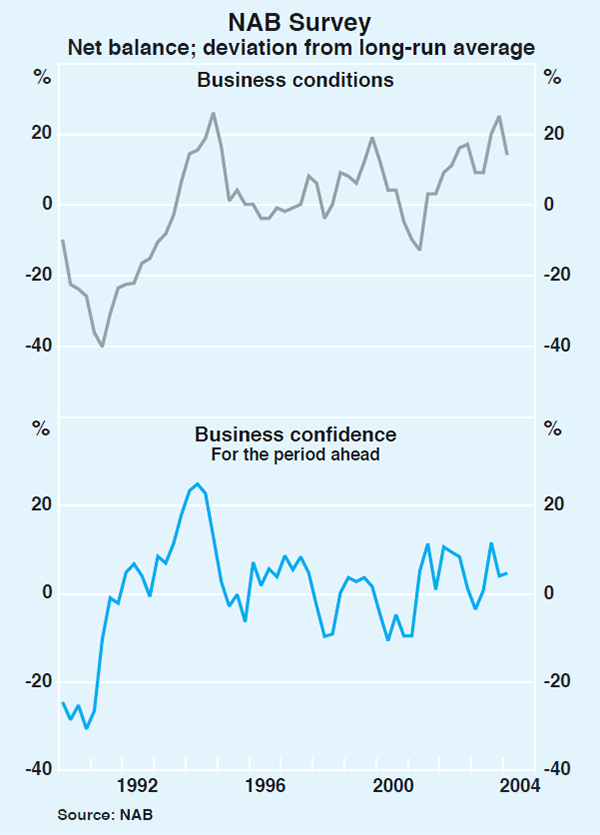
Looking ahead, various surveys show that business confidence and most indicators of expected activity are around or above long-run average levels. This is evident in the NAB survey, the Sensis survey of small and medium-sized firms, and the ACCI-Westpac and AIG March quarter surveys of manufacturing (Graph 39). The latter survey also suggests that manufactured exports have picked up following a fall in the December quarter.

Corporate profits increased solidly over 2003, rising by 12 per cent. Much of the strength has been in domestically focused industries such as transport & storage, and property & business services. The profitability of unincorporated non-farm businesses also remains strong. Profits of the farm sector as a whole continued to recover from the effects of drought, while mining profits were flat in the December quarter 2003, following falls in the previous three quarters. Looking forward, business surveys suggest profitability overall is expected to remain higher than average, though there has been some easing in the survey responses from the highs in late 2003.
The continued strength in corporate profits has provided ample internal funds for business investment. In addition, fund raising from external sources in 2003 was stronger than it had been in the previous two years, largely owing to solid growth in lending by financial intermediaries. In the first few months of 2004, however, external fund raising appears to have moderated, with business credit contracting slightly after rising rapidly in late 2003. Also, equity raisings eased from their strong pace in late 2003, though the outlook is positive, with several large initial public offerings expected to take place over the next few months. Corporate gearing ratios remain conservative by historical standards and debt servicing costs remain low, reflecting the relatively low level of interest rates.
Business investment has picked up considerably over the past two years, rising by over 30 per cent. Growth was robust over the second half of 2003, with investment rising by more than 4 per cent in the December quarter (Graph 40). The growth in the December quarter was driven primarily by a 10 per cent surge in non-residential construction activity, with sharp rises in work done in both the engineering and non-residential building components. Growth in machinery and equipment investment remained robust, increasing by 2 per cent in the quarter. Conditions remain generally supportive of further strong growth in investment, notwithstanding some recent concerns over the relatively high level of the exchange rate among firms subject to external pressures. In particular, despite falling from the peak reached in the December quarter, capacity utilisation is still at a high level and financial conditions remain favourable.
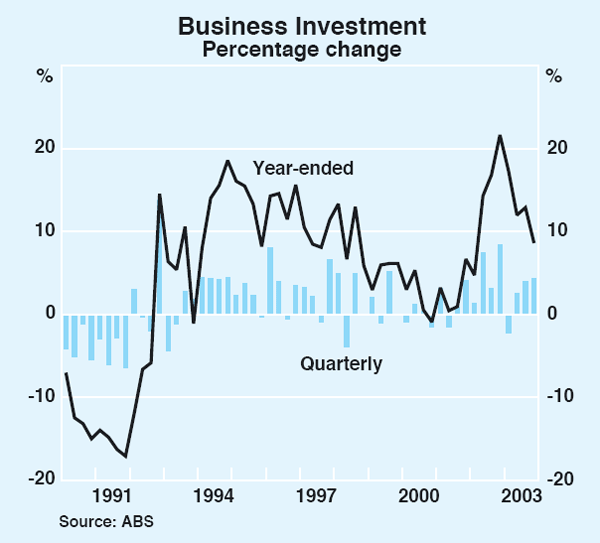
Surveys of investment intentions point to continued growth in business investment in real terms, albeit at lower rates than the robust growth seen through 2003. The Capex survey shows investment intentions for 2004/05 that are consistent with reasonably solid growth in machinery and equipment investment, especially in the mining and transport & storage sectors. In addition, the Rabobank survey suggests that investment in the farm sector – which is not included in the Capex survey – is likely to remain strong over the year ahead, at close to pre-drought levels.
Forward-looking indicators of investment in buildings and structures also suggest continuing strength in investment. Engineering construction activity has nearly doubled over the past two years and this upswing is likely to be sustained in the period ahead, with a number of significant road and mining-related projects scheduled for commencement in 2004 (Graph 41). The outlook for non-residential building activity is more mixed, with high levels of work in the pipeline likely to sustain activity for several quarters, but with falls in the value of building approvals suggesting some easing in the medium term. This is consistent with the Access Economics Investment Monitor, which indicates a decline in the value of non-residential building projects coming on stream in the period ahead.
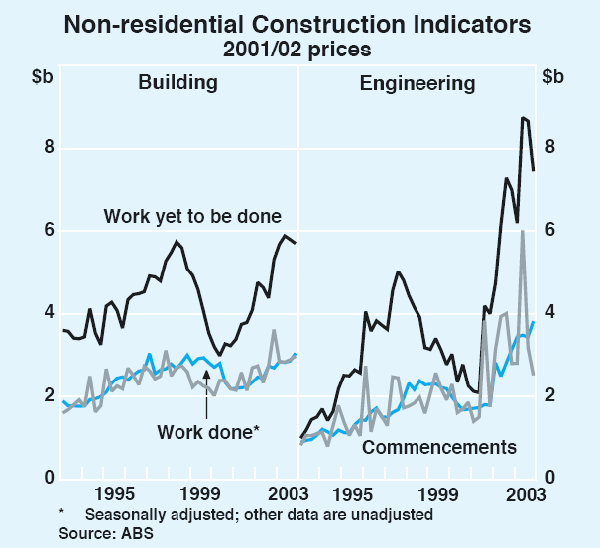
Labour market
The strong labour market conditions of 2003 have continued into early 2004 (Graph 42). Employment has grown at an average annualised rate of 3.4 per cent over the past six months, compared with an average of 2.1 per cent over the past decade. In the three months to March 2004, most of the gains were in full-time employment. This is consistent with the pattern of growth seen over the course of last year and confirms the underlying strength of the labour market.
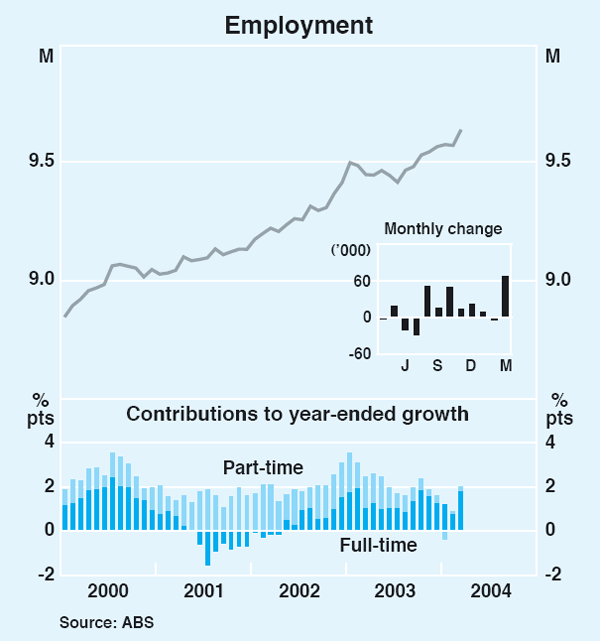
In line with solid employment growth, the unemployment rate has continued to edge lower in recent months, reaching 5.6 per cent in March 2004 (Graph 43). This is roughly equivalent to previous cyclical lows in 1981 and 1989. The participation rate increased to 63.7 per cent in March 2004, a relatively high level in comparison with the average of the past decade.
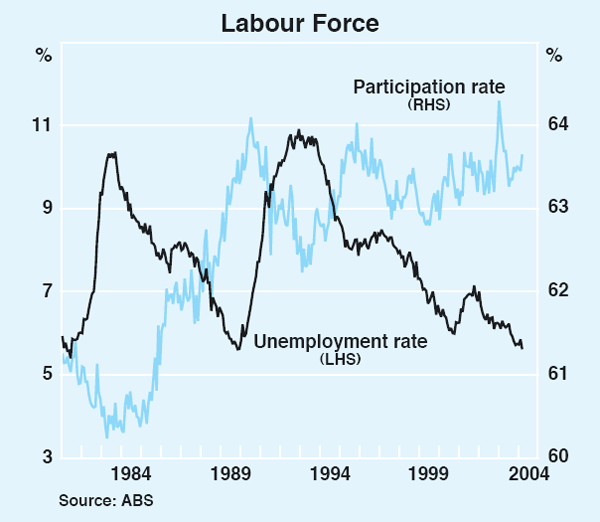
The recent gains in employment have been broadly based across states (Table 9). With the exception of South Australia, all states recorded substantial employment growth, with notable strength in Queensland, New South Wales and Tasmania. As a result, unemployment rates have fallen in most states.
| Employment growth in March quarter 2004 |
Unemployment rate | |||
|---|---|---|---|---|
| Quarterly | Semi-annual(a) | September quarter 2003 |
March quarter 2004 |
|
| NSW | 0.6 | 1.7 | 5.9 | 5.3 |
| Victoria | 0.8 | 1.4 | 5.6 | 5.6 |
| Queensland | 0.3 | 1.9 | 6.7 | 6.3 |
| WA | 0.5 | 1.5 | 6.2 | 5.6 |
| SA | 0.2 | −0.5 | 6.2 | 6.5 |
| Tasmania | 1.3 | 1.7 | 6.9 | 6.8 |
| Australia | 0.5 | 1.5 | 6.1 | 5.7 |
|
(a) Change from September quarter 2003 Source: ABS |
||||
Recent employment growth has been concentrated in industries that mainly service the household sector, such as health & community services, retail trade, and cultural & recreational services (Table 10). Employment in the finance and insurance sector also made a solid contribution to growth, as did mining employment, which has risen by around one-third since early 2001. Job shedding in recent quarters has been most pronounced in manufacturing, where businesses with relatively more exposure to trade are being adversely affected by the appreciation of the Australian dollar. Agricultural employment has been fairly stable in recent quarters, after having increased early last year. Even so, it remains well down on levels that prevailed before the drought.
| Selected industries | Share of total (2003) |
Growth Per cent | Contribution to growth Percentage points |
|---|---|---|---|
| Agriculture | 3.9 | 0.4 | 0.0 |
| Construction | 8.0 | 1.1 | 0.1 |
| Cultural & recreational services | 2.5 | 4.7 | 0.1 |
| Finance & insurance | 3.7 | 5.1 | 0.2 |
| Health & community services | 9.8 | 5.1 | 0.5 |
| Manufacturing | 11.4 | −1.0 | −0.1 |
| Mining | 0.9 | 20.6 | 0.2 |
| Retail trade | 15.3 | 1.3 | 0.2 |
| All industries | 100.0 | 1.3 | – |
|
(a) Data relate to mid month of the quarter Source: ABS |
|||
Forward-looking indicators suggest that employment will continue to grow strongly, albeit at a more moderate pace than of late. Print-based measures of vacancies published by ANZ and the DEWR posted strong gains over the three months to April, as did the ANZ measure of internet-based vacancies. The NAB and ACCI-Westpac surveys also suggest a positive near-term employment outlook, with hiring intentions well above long-run average levels (Graph 44).
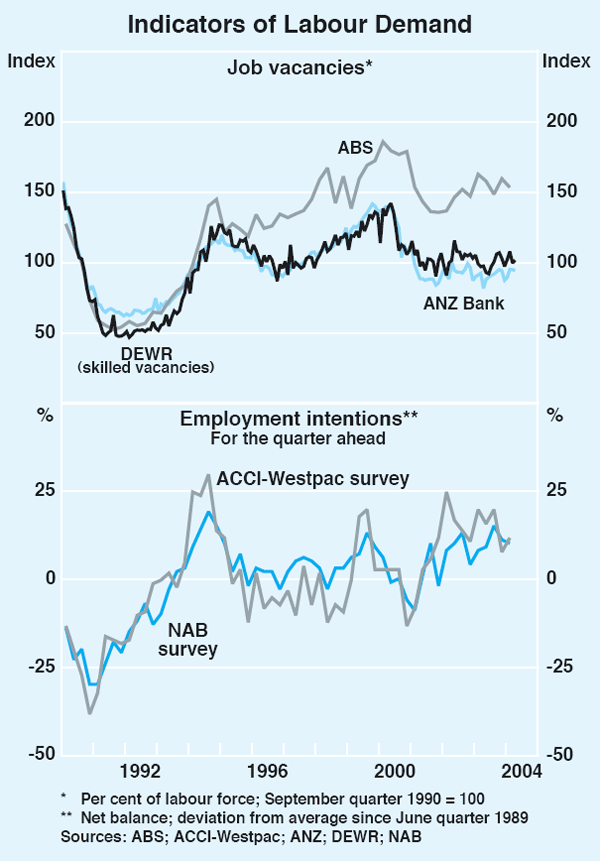
Balance of Payments
A modest improvement in Australia's trade performance has been evident since mid 2003. This follows a period in which exports had been constrained by the combined effects of weak global demand and drought, while imports were buoyed by rapid growth in domestic demand. These developments led to a substantial widening in the deficit on trade in goods and services, to as much as 3½ per cent of GDP in the June quarter 2003 (Graph 45). While strong domestic demand continues to support import growth, global demand has turned decisively in recent months and drought conditions have subsided, prompting some recovery in export volumes. The upswing in global demand has also boosted commodity prices, contributing to a sharp rise in the terms of trade to a 27-year high. This has resulted in a narrowing in the trade deficit since mid 2003 to around 3 per cent of GDP in the March quarter. Accordingly, the current account deficit has also narrowed somewhat over the same period to around 6 per cent of GDP in the March quarter (assuming that the net income deficit remains constant as a share of GDP).
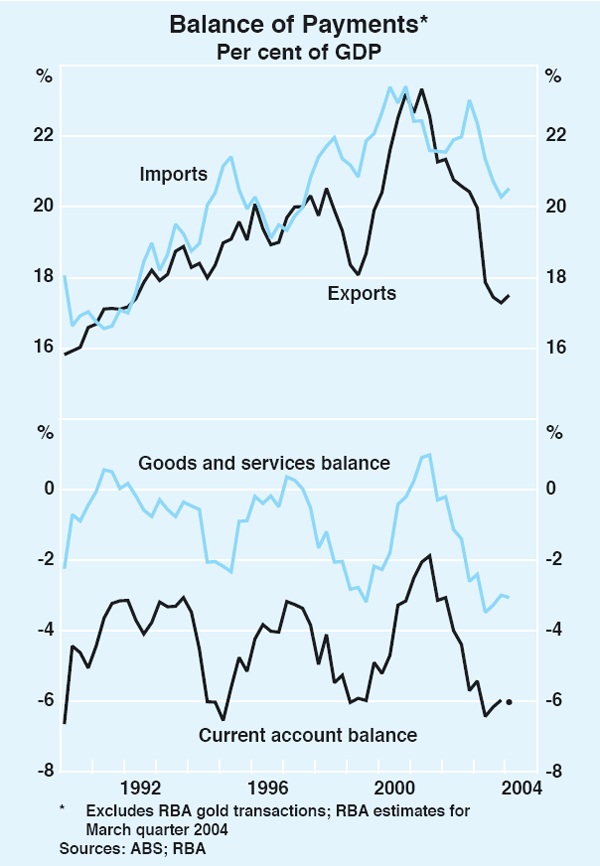
While the recovery in export earnings over the second half of 2003 was rather tentative, more recent data point to an increase in the pace of growth (Graph 46). The value of exports rose by around 2¾ per cent in the March quarter, reflecting a strong pick-up in the volume of rural exports, as farm production recovers from the effects of the drought. Ongoing gains in world commodity prices are also assisting growth in earnings by partially offsetting the dampening effect of the currency appreciation on Australian dollar export prices.
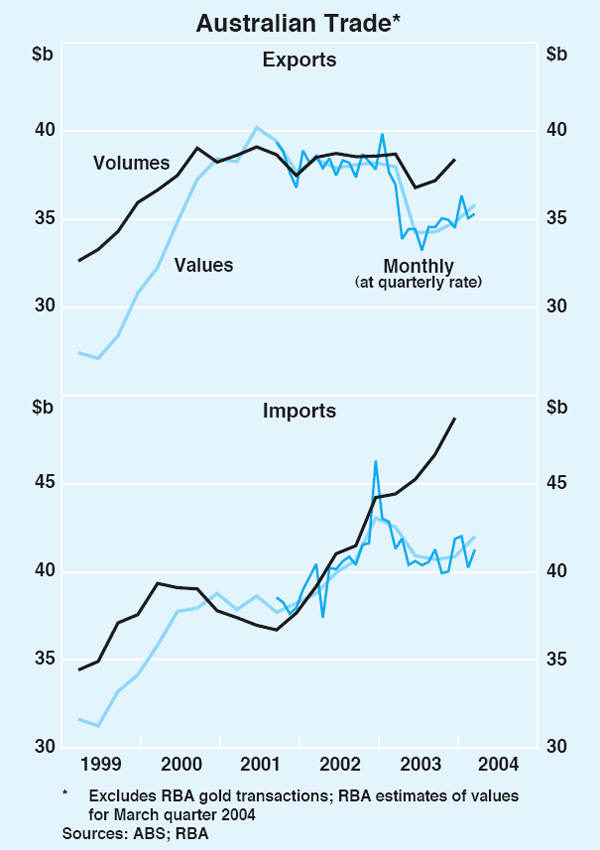
Rural exports have increased strongly from their drought-induced slump, rising in value by around 12 per cent in the March quarter, following a 7 per cent rise in the December quarter (Graph 47). To date, this increase has been driven largely by a rebound in exports of cereals, as the record 2003/04 winter crop is exported. However, the other major categories of rural exports also increased in value in the March quarter, particularly exports of meat. Looking ahead, the Australian Bureau of Agricultural and Resource Economics expects a decline in the winter cereals crop in 2004/05, as some land used for cropping to generate income quickly following the drought reverts to other uses; consequently, growth in crop exports is expected to slow significantly over this period. Production of livestock-based products should increase steadily over the next few years, underpinning a gradual expansion in exports of these goods.
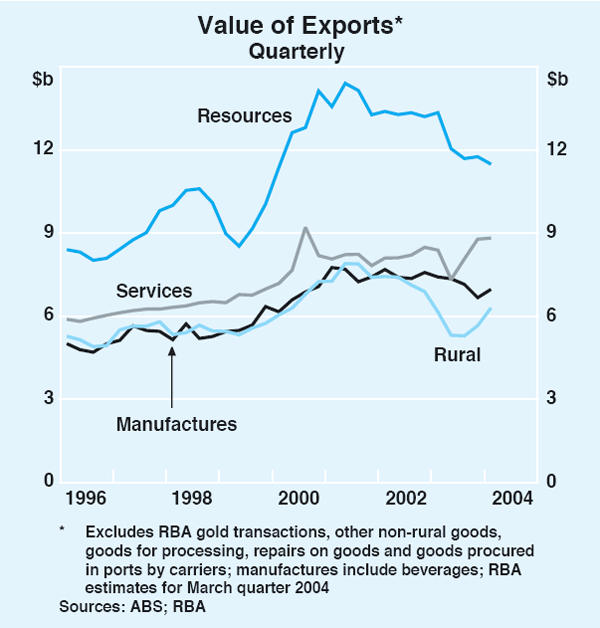
Service exports have also made a key contribution to the recent recovery in export earnings. The value of service exports grew rapidly over the second half of 2003, reflecting a resumption of international travel following the containment of SARS, tourist spending associated with the Rugby World Cup, and stronger world growth. Service exports have since paused at a high level as the impetus from the Rugby World Cup has waned, rising in value by ½ per cent in the March quarter; this is in line with ongoing strength in overseas arrivals relative to that in recent years (Graph 48). The outlook for service exports remains generally favourable, given improved prospects for global economic growth, and tourism bodies currently report high levels of forward bookings.
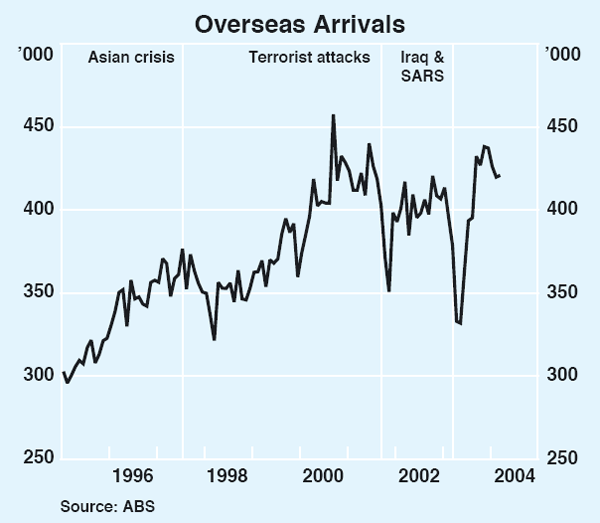
Following sharp falls in mid 2003, the value of resource exports fell further in the March quarter by around 2 per cent, to be about 14 per cent lower than a year ago. The decline in earnings over the past year owes largely to a fall in Australian dollar prices, as the appreciation of the Australian dollar has more than offset rising world commodity prices evident since mid last year (see section on commodity prices and the terms of trade below). However, resource export volumes rose modestly over 2003, with a sharp increase in the December quarter retracing earlier falls. This recent pick-up in export volumes stems from rising global demand and efforts to redress capacity constraints; it has been most pronounced in exports of coal. While growth in volumes appears to have eased in the March quarter, strong investment in the mining sector is expected to expand capacity this year, which along with robust demand, should underpin firm growth in resource exports over 2004.
Manufactured exports have also shown signs of recovery, following weakness through much of 2003. In value terms, manufactured exports rose by 5 per cent in the March quarter, though they remained around 6 per cent lower over the year. The fall in values over 2003 was due largely to a decline in Australian dollar prices, as a result of falls in the world price of many manufactured goods coupled with the effects of the appreciation of the Australian dollar over this period. However, export volumes also fell over 2003, with manufacturers losing competitiveness in international markets. This fall in volumes contrasts with the rapid growth seen during much of the 1990s. With an upswing in world demand now firmly established and upward pressure on the Australian dollar easing recently, growth in manufactured export volumes is likely to resume over 2004. While the extent of the pick-up in manufactured export earnings in the March quarter suggests that a recovery is already underway, growth in the period ahead is likely to be more moderate than during the 1990s.
Import volumes continue to grow rapidly, with broad-based increases underpinned by robust growth in domestic spending and falling import prices (refer Graph 46). After rising modestly over the first half of 2003, import volumes increased at an annualised rate of 16 per cent over the second half of the year, more than double the trend rate. This reflected a jump in service imports as the stronger Australian dollar spurred a surge in international travel by Australians. Imports of goods also expanded at a firm pace in the second half of 2003, particularly consumption imports, which rose in line with robust consumer spending to be around 12 per cent higher over the year; imports of capital and intermediate goods were also sharply higher over the year. In contrast to the strength in volumes, the value of total imports declined by around 5 per cent over the year to the December quarter, as the currency appreciation has lowered Australian dollar import prices. However, an increase in import values of around 3½ per cent in the March quarter, despite another decline in prices, points to a further rapid expansion in import volumes.
The net income deficit rose slightly in the December quarter of 2003 to $5.9 billion, though at 3.0 per cent of GDP, it remains around its average of the past five years. This increase stemmed from a rise in net payments on foreign debt, consistent with the upward trend in Australia's net offshore borrowing. The rise in payments on foreign debt in the December quarter was partly offset by a decline in dividend payments on foreign holdings of Australian equity.
Commodity prices and the terms of trade
Commodity prices in SDR terms remain on a firm upward trend, buoyed by the global economic recovery and the associated pick-up in demand for raw materials. After rising strongly over the second half of 2003, the RBA Index of Commodity Prices increased by 3.1 per cent in SDR terms over the three months to April, to be 13½ per cent above its trough in May 2003 (Table 11, Graph 49). The increase over the latest three months was due to a strong rise in the prices of bulk commodities and, to a lesser extent, base metals. While the appreciation of the Australian dollar over the past year or so has restrained commodity prices in Australian dollar terms, they remain close to their average of the past decade.
| Three months to April |
Year to April 2004 |
|
|---|---|---|
| RBA Index | 3.1 | 10.6 |
| Rural | −2.0 | 4.3 |
| – Wheat | 6.7 | 9.2 |
| – Beef and veal | −13.1 | 15.9 |
| – Wool | −4.3 | −15.3 |
| Base metals | 4.8 | 38.6 |
| – Aluminium | 9.8 | 21.2 |
| – Copper | 23.6 | 72.3 |
| – Nickel | −13.7 | 50.9 |
| Other resources | 5.8 | 6.3 |
| – Coking coal(a) | 8.0 | −3.0 |
| – Steaming coal(a) | 19.7 | 13.5 |
| – Gold | −0.4 | 15.0 |
| Memo item: | ||
| Oil in US$(b) | 7.7 | 29.7 |
|
(a) Latest available data are for March. Sources: Bloomberg; RBA |
||
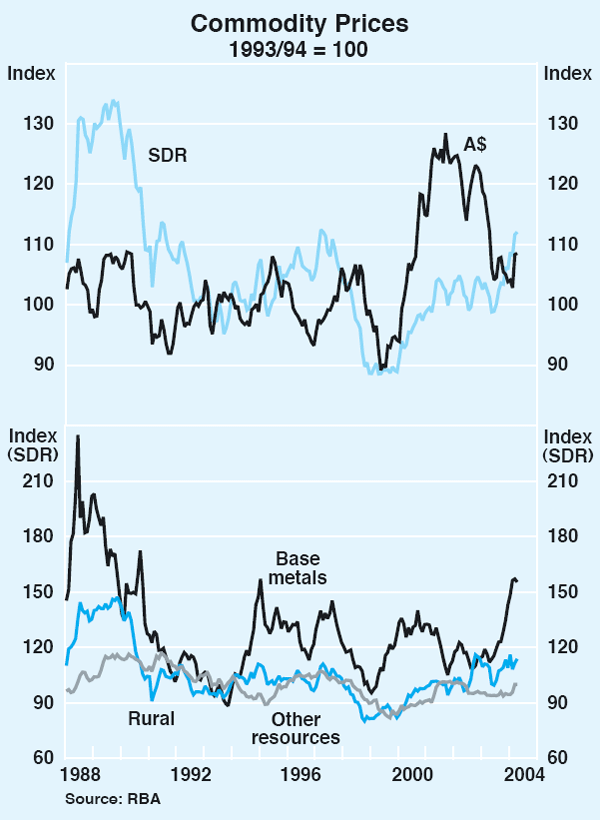
Base metals prices have been volatile in 2004. Over the three months to April, they rose by 4.8 per cent in SDR terms, reflecting steep increases in the prices of copper and aluminium, taking year-ended growth to almost 40 per cent. These price increases have been driven by low stocks and expanding global industrial production, and have taken base metals prices close to 15-year highs. Despite the exchange rate appreciation, prices in Australian dollar terms have also increased significantly over the year to be well above the average level of the past decade. However, recent weeks have seen sharp falls in base metals prices in response to market concerns over the sustainability of growth in China. In addition, nickel prices have fallen in recent months, as earlier disruptions to supply have been resolved, but remain high as a result of buoyant demand and low inventories.
The prices of other resource commodities increased on average by 5.8 per cent over the three months to April, driven by increases in the prices of alumina, coal and iron ore. The export prices of coal and iron ore are heavily influenced by the outcomes of longer-term contract negotiations, and contract prices are currently lagging recent price strength evident in spot markets. The US dollar spot price of steaming coal has increased by nearly 110 per cent over the past year in response to growing demand from Europe and Asia as well as shipping capacity constraints. Recent negotiations have secured large increases in steaming coal contract prices for 2004 – reportedly as high as 70 per cent in US dollar terms – which will substantially increase prices received by exporters in coming months. Rapid growth in global steel demand has also boosted contract prices for other bulk commodities; coking coal contract prices increased, on average, by 25–35 per cent in US dollar terms in recent negotiations, while iron ore contract prices have risen by close to 20 per cent. When the outcomes of recent contract negotiations have their full effect, they are likely to add around 6 percentage points to the RBA Index of Commodity Prices.
Rural commodity prices fell slightly over the three months to April, after increasing strongly over the second half of 2003. While rural prices are below the drought-induced peaks of 2002, they remain higher than the average of the past decade in both SDR and Australian dollar terms.
While growth in world prices for Australia's exports has been strong recently, growth in world prices for Australia's imports, particularly manufactured goods, has been quite weak. As a result, Australia's terms of trade has increased by 6.4 per cent over the past year, to its highest level in over 27 years (Graph 50). With considerable upward momentum in commodity prices, particularly for bulk commodities, the terms of trade is likely to have increased further in the first half of 2004.
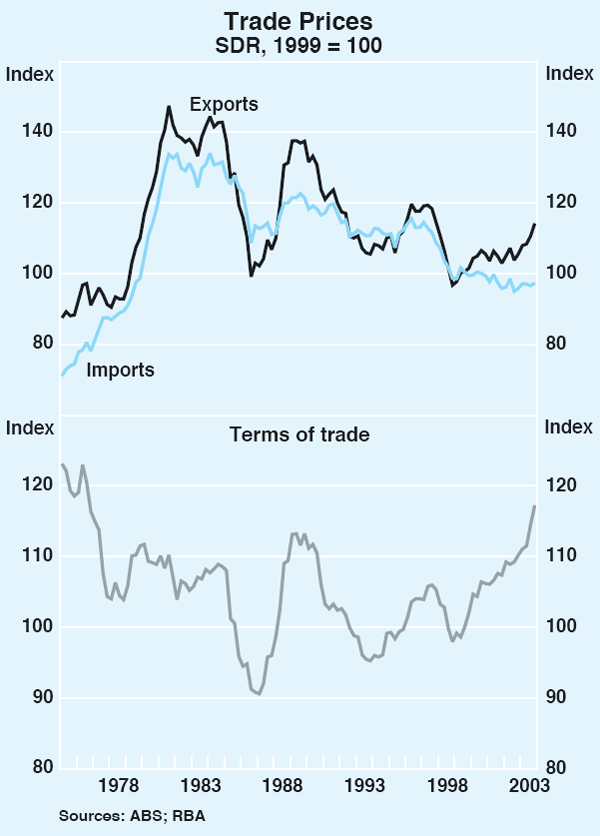
Domestic Financial Markets
Interest rates and equity prices
Money and bond yields
While the cash rate has been held steady at 5.25 per cent so far in 2004, financial markets on balance continue to expect some further tightening in the months ahead. These expectations receded for a time during the March quarter in response to signs of some cooling in the housing market, strength in the exchange rate and reduced likelihood of a tightening by the US Fed after a couple of weak US employment numbers. By mid March the short-term yield curve had become quite flat. However, since then, even though the housing market still looks to be softening, expectations of a domestic monetary tightening in the months ahead have re-emerged (Graph 51). This has mainly been due to external factors – the growing signs of strength in the global economy and the bringing forward of expectations for a Fed tightening. Markets are currently pricing in a further tightening of 25 basis points in the second half of 2004. In line with this, yields on 90-day bank bills are trading at 5.6 per cent and those on 180-day bills are at 5.7 per cent.
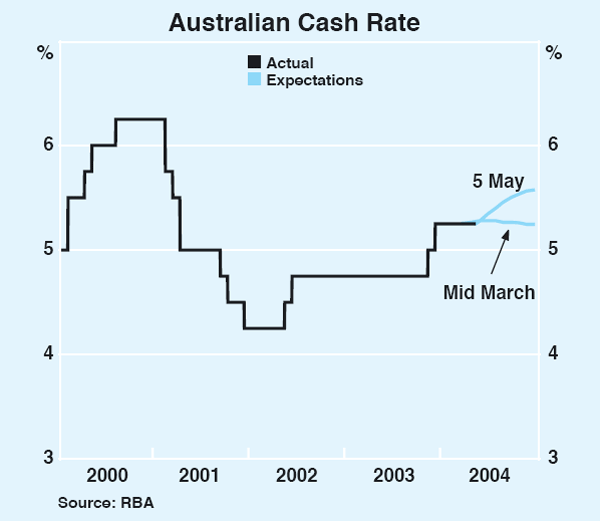
The same influences that caused short yields first to fall and then rise again have also impacted further out along the yield curve, with somewhat more pronounced effects. Yields on 10-year bonds fell by around 40 basis points, to 5.3 per cent, by early March but are now around 5.9 per cent – a net rise of 25 basis points since the time of the last Statement. Yields on inflation-linked bonds have moved in a similar pattern and are now around 3.4 per cent (Graph 52).
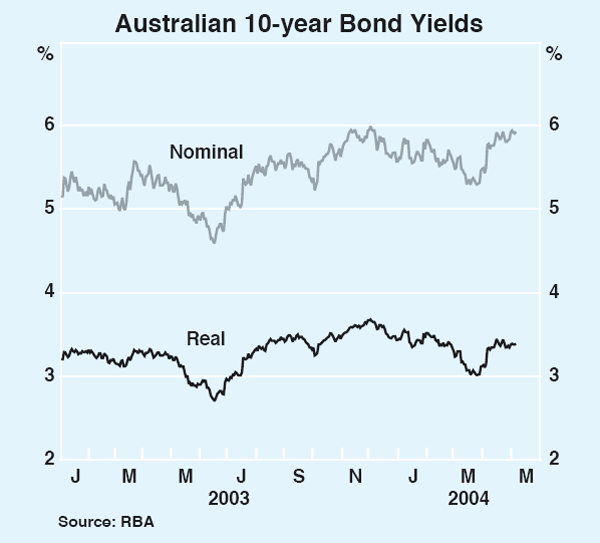
The more pronounced movements in longer-term bond yields saw the spread between the yield on 10-year bonds and the cash rate rise in net terms over recent months to around 65 basis points. This is still below its average for the past decade.
The net rise in Australian long bond yields over recent months has been less than in corresponding US yields, so the spread between Australian and US yields has narrowed. In early May, it was around 135 basis points, around 20 basis points lower than earlier in the year (Graph 53).
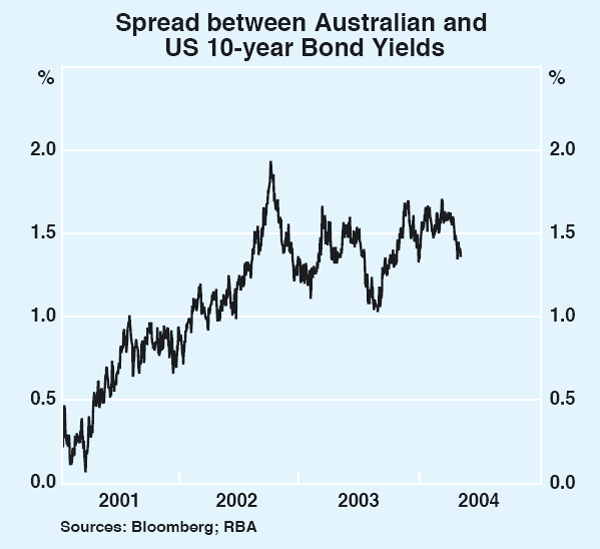
There has been little change in the market's perceptions of credit risk during the past three months. Premia on credit default swaps (CDS), which measure the cost of insurance against a company defaulting, have increased slightly but remain close to their historical lows (Graph 54). While spreads between yields on highly-rated corporate bonds and government bonds have remained above their historical averages, this continues to reflect strong demand for Commonwealth Government bonds rather than concerns about corporate credit quality. Market contacts have reported that it also reflects the relatively high level of swap rates – a common benchmark for price-makers' funding costs – for reasons related more to the demand for funds than to credit concerns. Consistent with this, spreads between corporate bond yields and swap rates have moved much more in line with CDS than have spreads between corporate bonds and CGS.
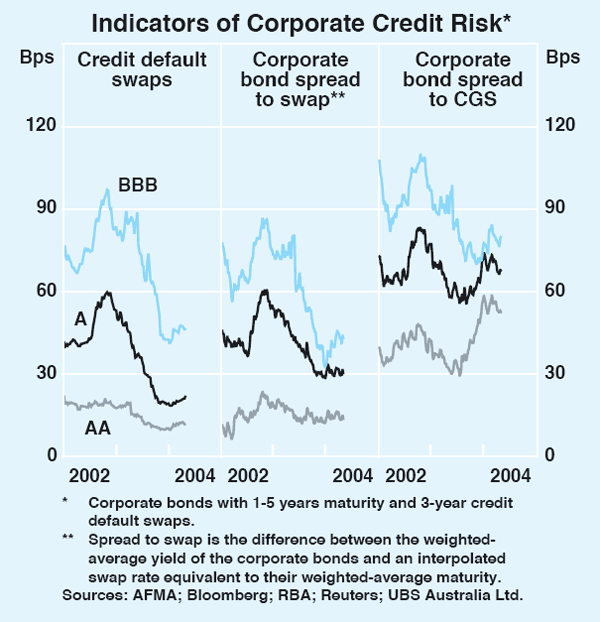
Intermediaries' interest rates
Intermediaries' variable indicator lending rates have been unchanged since December 2003, consistent with there having been no change in the cash rate since then. Interest rates on fixed-rate loans to small business and for housing have fallen marginally since their respective peaks in late 2003, in line with the change in banks' cost of funding fixed-rate loans (Graph 55). The share of new housing loans taken out at fixed rates has fallen from a peak of around 15 per cent in November, to under 10 per cent in February, which is around the average for the past two years. The average 3-year fixed housing rate is currently around 7 per cent, just below the banks' predominant standard variable rate (Graph 56, Table 12).
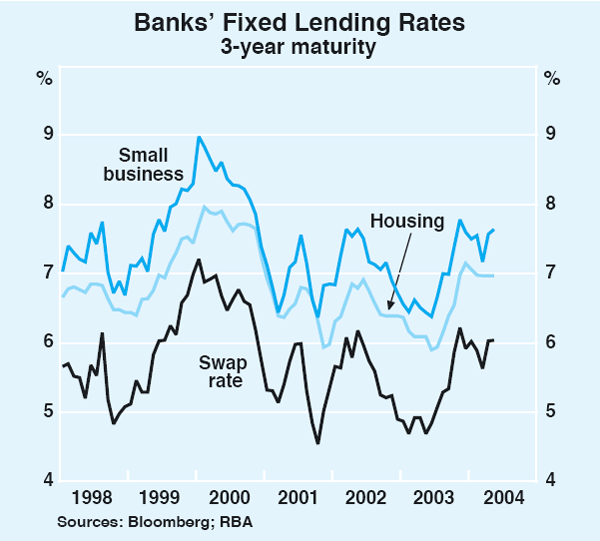
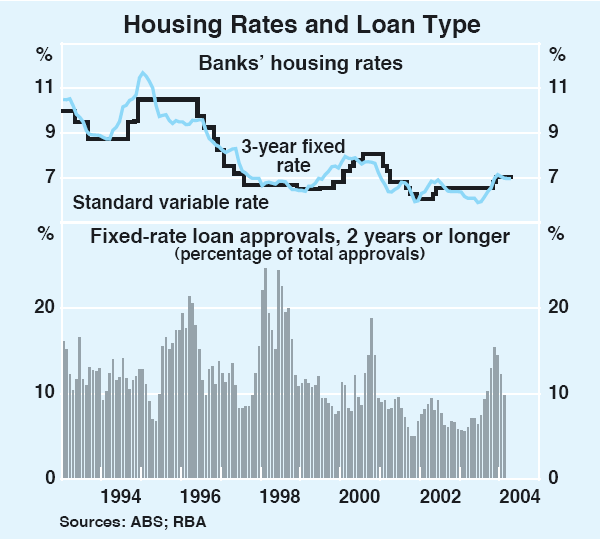
| Current level (5 May) |
|
|---|---|
| Variable rates | |
| Household | |
| Mortgages: | |
| – Standard variable | 7.05 |
| – Basic housing | 6.50 |
| – Mortgage managers | 6.70 |
| Personal lending: | |
| – Residential security | 7.20 |
| – Credit cards | 16.45 |
| Small business | |
| Residential security: | |
| – Overdraft | 7.95 |
| – Term loan | 7.25 |
| Other security: | |
| – Overdraft | 8.85 |
| – Term loan | 7.85 |
| Large business | |
| – Overdraft | 8.85 |
| Fixed rates (3 years) | |
| – Housing | 6.95 |
| – Small business | 7.65 |
| – Swap rate | 6.05 |
|
Source: RBA |
|
Equity prices
Australian share prices have risen by 4 per cent since the time of the last Statement. The ASX 200 is currently 3 per cent below its 2002 high, while the broader All Ordinaries index (which includes more companies and does not adjust the weights of companies for their ‘free float’) reached a new all-time high during March. The two indices have tracked each other closely during recent years, with the All Ordinaries rising only slightly faster than the ASX 200 since their lows in March 2003.
Since end January, Australian equities have risen by more than world equity prices and continued to be markedly less volatile (Graph 57).
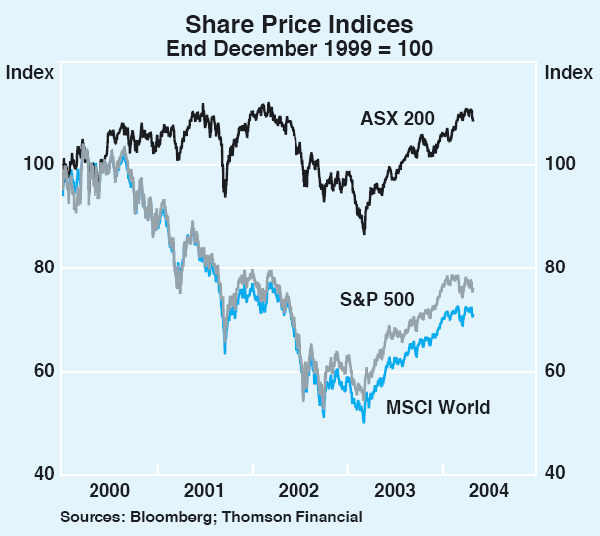
Six out of the ten sector indices in the ASX 200 index have risen since end January (Table 13). The energy sector rose by 11 per cent, largely reflecting strong oil prices and refining margins and several exploration successes. In contrast, the materials sector fell slightly, in part due to some falls in commodity prices and concerns that demand from China may ease. The financials sector rose by 4 per cent on the back of strong profits results, particularly for insurance companies. The consumer discretionary sector has risen by 9 per cent since the previous Statement, with more than half of the increase occurring after the announcement of News Corporation's proposed plan to move its corporate headquarters to the US.
| GICS Sector | ASX 200 | MSCI World |
|---|---|---|
| Consumer discretionary | 8.8 | 2.5 |
| Consumer staples | 7.1 | 6.2 |
| Energy | 10.7 | 9.9 |
| Financials | 4.4 | 0.0 |
| Health care | 9.4 | 2.5 |
| Industrials | −0.1 | 0.4 |
| Information technology | −7.3 | −7.9 |
| Materials | −0.6 | 0.3 |
| Telecommunication services | −4.2 | −0.5 |
| Utilities | 1.6 | 3.0 |
| Composite | 3.6 | 0.9 |
|
Sources: Bloomberg; Thomson Financial |
||
The Australian price/earnings (P/E) ratio has fallen slightly since the previous Statement to around 19, which is broadly in line with its long-run average. Australian dividend yields have continued to average just below 4 per cent (Graph 58).
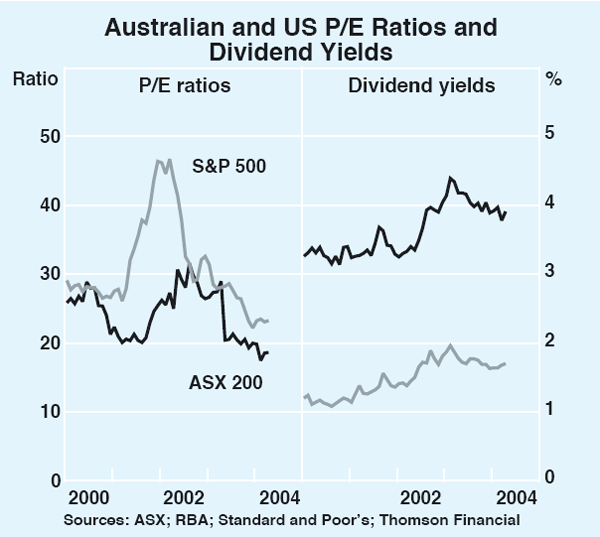
Financing activity
Debt markets
Australian non-government entities issued a record $44 billion of bonds in the March quarter, with financial institutions and asset-backed vehicles both issuing large amounts, particularly in offshore markets (Table 14). Issuance by non-financial institutions was relatively subdued, at $2.5 billion.
| Sector | 2001 | 2002 | 2003 | 2004 | |
|---|---|---|---|---|---|
| March quarter |
April | ||||
| Bond issues by Australian entities | |||||
| Onshore | |||||
| Financial institutions | 6.0 | 7.4 | 9.8 | 2.5 | 0.6 |
| Non-financial institutions | 5.9 | 7.6 | 4.9 | 1.0 | 0.1 |
| Asset-backed | 15.0 | 19.3 | 21.2 | 5.9 | 1.0 |
| Total | 26.9 | 34.3 | 35.9 | 9.4 | 1.7 |
| Offshore | |||||
| Financial institutions | 29.3 | 31.8 | 49.6 | 17.8 | 7.2 |
| Non-financial institutions | 6.8 | 7.5 | 14.5 | 1.5 | 0.2 |
| Asset-backed | 14.3 | 16.5 | 24.0 | 15.1 | 0.8 |
| Total | 50.4 | 55.9 | 88.0 | 34.4 | 8.2 |
| Total | 77.3 | 90.2 | 123.9 | 43.8 | 9.9 |
| A$ bond issues by non-resident entities | |||||
| Onshore | 7.8 | 3.1 | 7.1 | 8.7 | 1.2 |
| Offshore | 4.3 | 17.3 | 24.4 | 5.5 | 1.2 |
| Total | 12.1 | 20.4 | 31.5 | 14.1 | 2.4 |
|
Source: RBA |
|||||
As usual, most offshore issuance was denominated in foreign currencies, with companies typically using swap markets to hedge the proceeds back to Australian dollars. Financial institutions continued to diversify their funding sources, borrowing predominantly in pounds sterling, euros and Canadian and US dollars, while asset-backed issuance was fairly evenly divided between US dollars and euros (Graph 59).
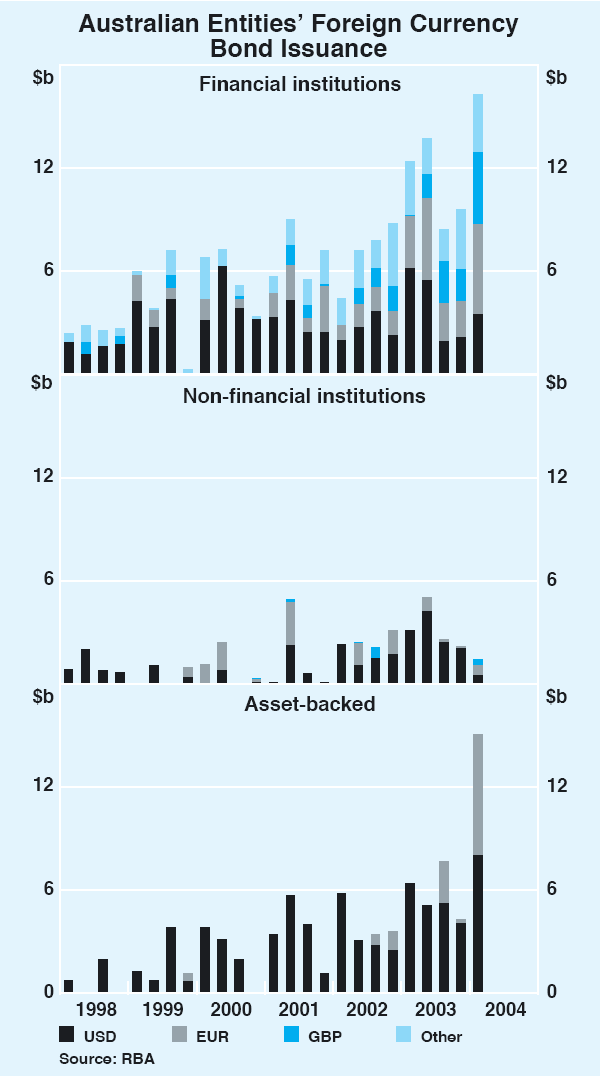
Non-residents' issuance of Australian-dollar denominated debt was also very strong, with $14 billion of bonds issued during the March quarter (Graph 60). Unlike the surge in non-residents' Australian dollar issuance that occurred in early 2003, which was driven by strong Uridashi issuance, the majority of the recent A$ issuance was into the domestic market. Issuers were split fairly evenly between financial institutions and supranational/government entities. Box B discusses some of the reasons for the recent strength in non-residents' issuance into the Australian market.
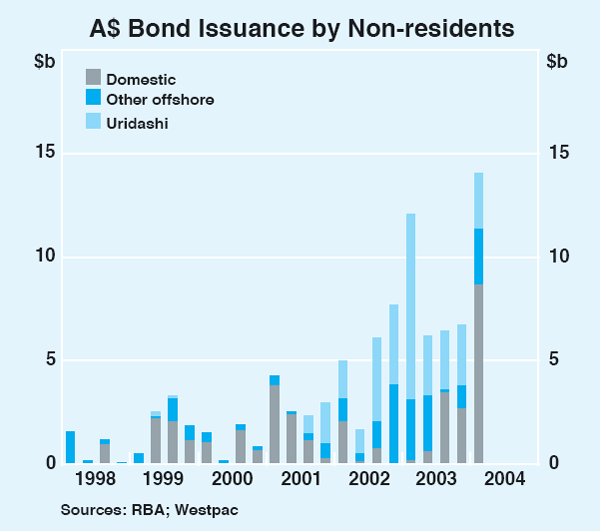
Total issuance of bonds in the Australian market by all non-government borrowers (including non-residents) was almost $20 billion in the first quarter of 2004, significantly up on the same period in earlier years (Graph 61). As a result of the record domestic issuance, outstandings of non-government debt are now almost triple the amount outstanding of either Commonwealth Government bonds or state government bonds, both of which were broadly unchanged in the March quarter at around $50 billion (Graph 62).
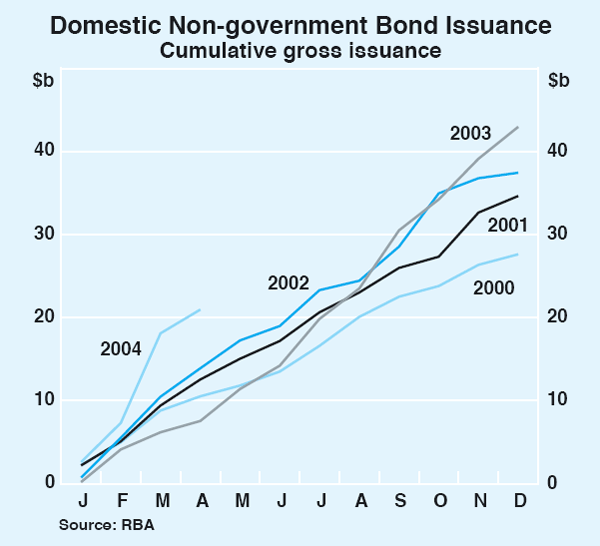
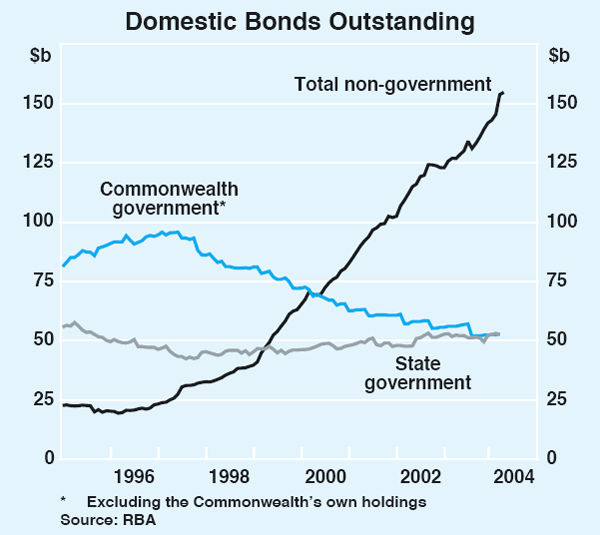
Intermediated borrowing
The growth rate of total credit remains strong, rising by 15 per cent over the year to March, a little below its growth rate of 15½ per cent at the beginning of the year. Household credit has continued to grow at the very high rates recorded over the second half of 2003, with only tentative signs of easing emerging. Business credit has slowed more noticeably, and has been the main contributor to the slight moderation in total credit growth.
Household credit continues to grow at a fast pace, increasing by 22 per cent over the year to March. The main driver of this growth has been borrowing for housing, with credit extended to both investors and owner-occupiers continuing to increase rapidly (Graph 63). However, there are early signs of a moderation in borrowing to fund the purchase of investor housing. Over the three months to March, credit extended to investors grew at an annualised pace of 26 per cent, compared with a rate of over 30 per cent during the second half of last year. In contrast to the easing in investor credit, growth in borrowing for owner-occupied housing has remained firm, consistent with its initial pick-up in the second half of last year having been less sharp than that for investor housing. Personal credit has also grown strongly, rising by 15 per cent over the year to March.
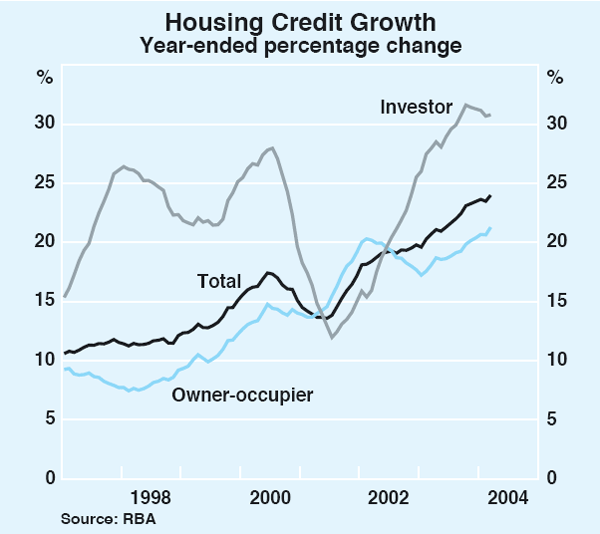
The recent falls in housing loan approvals point to the possibility of greater moderation in housing credit growth in the near term. However, as noted in the chapter on ‘Domestic Economic Conditions’, housing loan approvals remain at a high level, which suggests that further falls in approvals would be required for housing credit growth to fall to a sustainable pace.
Business credit has experienced a more marked turnaround in recent months than has housing credit, with falls recorded in the latest two months, reflecting a contraction in commercial loans and an easing in intermediation of businesses' debt securities. However, this follows two quarters of very strong growth in corporate borrowing and debt raisings, and the growth in business credit, of 6 per cent over the year to March, remains in line with the average of recent years.
On the liability side of intermediaries' balance sheets, the growth rate of the broader monetary aggregates has continued to rise. Broad money increased at an annual rate of 14 per cent over the six months to March, compared with 16 per cent growth in total credit (Graph 64). This narrowing in the difference between the rates of growth of broad money and total credit implies that, over this period, institutions relied relatively less on funding sources that are not included in broad money.
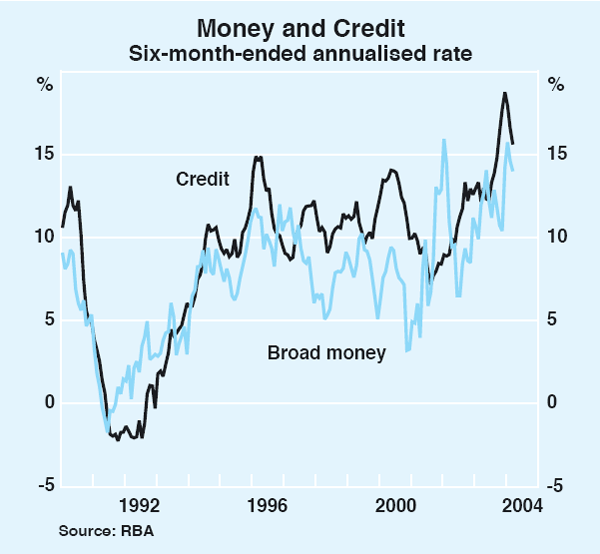
Equity raisings
Net equity raisings totalled $4.5 billion in the March quarter (Graph 65). While this was down from the particularly strong raisings of $10 billion in the December quarter, the figure was in line with the quarterly average since the start of 2000.
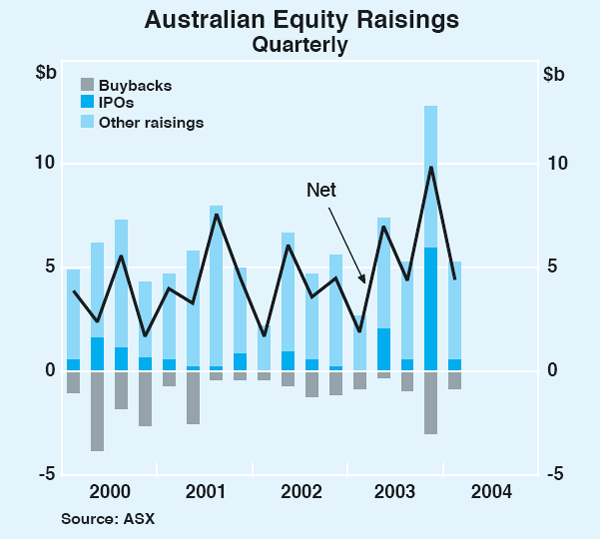
Box B: Non-resident Issuance in the Australian Bond Market
After a two-year hiatus, a broad range of non-resident issuers returned to the Australian bond market in mid 2003 and were particularly active in the first quarter of 2004 (Graph B1). While these entities' total Australian dollar raisings typically represent a small share of their overall raisings – around 5 per cent in the case of supranationals – they are an important source of credit diversification (without currency risk) for local investors.
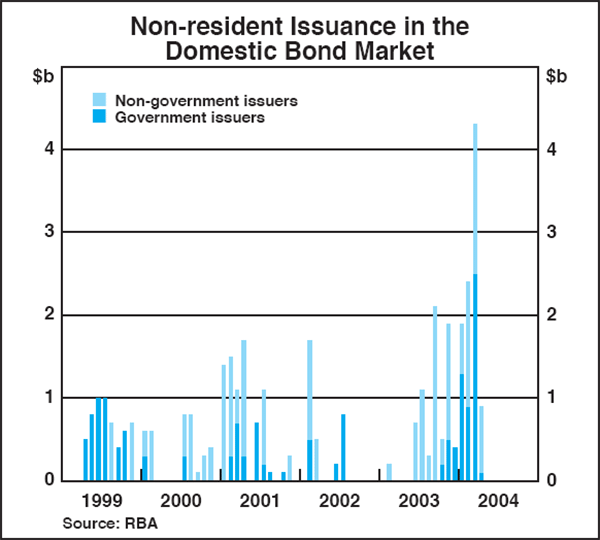
The increase in issuance has been due to a fall in the relative cost of issuing debt in Australia. The two main components of this are corporate bond spreads and the cost of hedging the proceeds back to the home currency of the issuer. (The available evidence suggests non-residents swap the bulk of their Australian dollar issuance back into their home currencies.)
Credit spreads (relative to swap rates) in the Australian bond market have been quite low recently for both non-government and government non-resident borrowers, and are likely to have encouraged the surge in Australian dollar issuance (Graph B2). One factor contributing to the low spreads may be the strength of demand for such debt by investors who regard it as an alternative to CGS, which are in short supply. Demand is also coming from foreign investors, including central banks, seeking an Australian dollar exposure. The broadening of the RBA's eligibility criteria for market operations, to include a wider range of bonds issued by foreign governments, at the margin has also increased demand for these bonds.
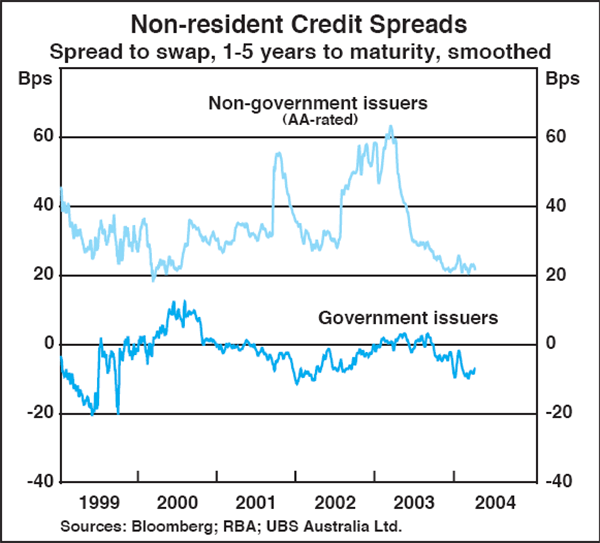
Foreign borrowers issuing in Australia and seeking to swap back to their home currency usually receive favourable prices in the currency swap market because of greater demand by Australian borrowers to do the reverse – i.e. borrow in foreign currency and swap into Australian dollars. Record foreign currency bond issuance by Australian entities in 2004 has pushed up the cost of converting foreign currency to Australian dollars and made it cheap for foreigners to do the opposite (Graph B3).
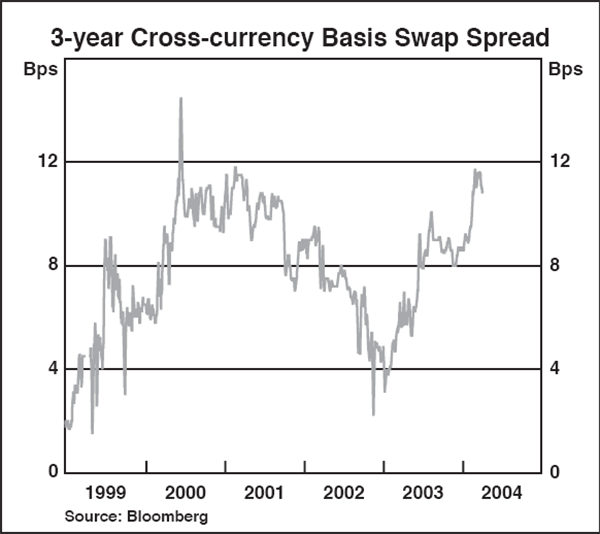
While corporate spreads in major foreign markets have also declined in recent months, this has not been sufficient to offset the combined effect of the fall in Australian credit spreads and the rise in currency swap premia. As a result, the relative cost of issuing in Australia has decreased.
Financial Conditions
Total credit increased at a rate of around 15 per cent over the year to March, only a little less than the peak rate reached at the beginning of the year. As has been the case over the past five years, credit expansion in recent months has primarily been driven by household sector borrowing, especially for housing. Housing-related credit expanded by 24 per cent over the year to March and, though growth has remained at an unsustainably rapid pace in recent months, loan approvals data point to some easing in the near future. In contrast, the strong growth in business credit seen late last year has been reversed, with falls recorded in the latest two months.
Early signs of easing in housing credit growth are most clearly evident in investor finance, consistent with a decline in sentiment towards purchasing investment properties. Despite recent moderation, investor housing credit still grew at a very rapid pace, increasing by 31 per cent over the year and at an annualised rate of 26 per cent over the three months to March. Growth in lending to owner-occupiers has also remained very strong, and only a little lower than the recent growth rate of investor housing credit.
Although the recent decline in the value of housing loan approvals does point to some moderation in housing credit growth in the coming months, at this stage, the value of loan approvals remains at a high level that is still consistent with rapid ongoing growth in credit. The measures announced by the NSW and Victorian state governments in April and May, discussed in more detail in the ‘Domestic Economic Conditions’ chapter, are expected to start to have some effect on loan approvals and credit over the next few months. While these changes should support the participation of owner-occupiers in these states, they are expected to make property investment less attractive in NSW.
The debt-servicing ratio on household borrowing has now surpassed its late 1980s peak, and is set to rise further over the first half of 2004, given current rates of household credit growth. At some point, increases in the debt-servicing ratio should eventually begin to constrain households' ability to increase their indebtedness. However, there are as yet no signs of such a constraint, with household credit still growing strongly. Consumer spending remains strong, with buoyant consumer sentiment and personal credit still growing at a firm pace. Credit remains readily available to prospective borrowers, despite reports that lenders had earlier tightened criteria on loans for the purchase of inner-city apartments.
In the business sector, balance sheets remain in good shape, and firms appear to have ample access to finance from a variety of sources. Despite the falls in recent months, business credit is around 6 per cent higher over the year to March. Businesses have access to a high level of internal funding from retained earnings, and they have been able to raise funds through equity and non-intermediated debt issuance. Solid investor sentiment has been reflected in the strong performance of the share market since March last year, and in the fact that a number of large initial public offerings are expected to take place over the next few months. Sentiment about corporate credit quality also remains positive, with spreads on corporate bonds over swap rates at low levels by historical standards.
The strength in credit growth, especially for households, has reflected strong demand for borrowing, a relatively low cost of finance and high consumer confidence. Both the cash rate and other variable lending rates remain below their averages over the past decade (Graph 66). While variable lending rates have remained unchanged since the end of last year, fixed housing and fixed small business lending rates have both fallen from their peaks late last year, by around 20 and 15 basis points respectively.

Despite large swings over the past month or so, the yield on 10-year bonds overall has risen slightly since the beginning of the year, largely mirroring events in US markets. This rise in Australian bond yields has resulted in a modest widening in their spread to the cash rate; that is, the yield curve has become a little steeper. Nonetheless, at around 65 basis points, the slope of the yield curve remains below its medium-term average (Graph 67). Normally, this would be read as an indicator of tighter-than-average financial conditions, but in the current situation it is probably best interpreted as symptomatic of developments in offshore markets. Global bond yields remain relatively low, reflecting expectations that global interest rates are still likely to remain low for some time, notwithstanding upward revisions to those expectations in the past couple of months.
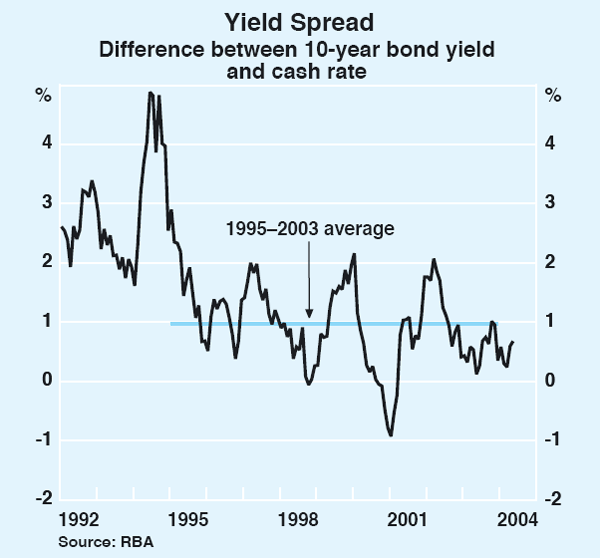
The Australian dollar has depreciated from its mid-February peak, by around 6½ per cent on a trade-weighted basis, following a period of strong appreciation over the previous year and a half. As a result, the exchange rate is 10 per cent higher over the past year, and in real terms is around 11 per cent above its post-float average (Graph 68). The appreciation of the exchange rate occurred over a period when the general international environment became more favourable for Australian exporters in a number of respects. Australia's terms of trade, a measure of the relative price of Australia's exports to the price of imported items, rose to its highest level in 27 years in the December quarter, and the recent strength in many international commodity prices, particularly in the resources sector, suggests that the terms of trade has risen further over the first few months of 2004.
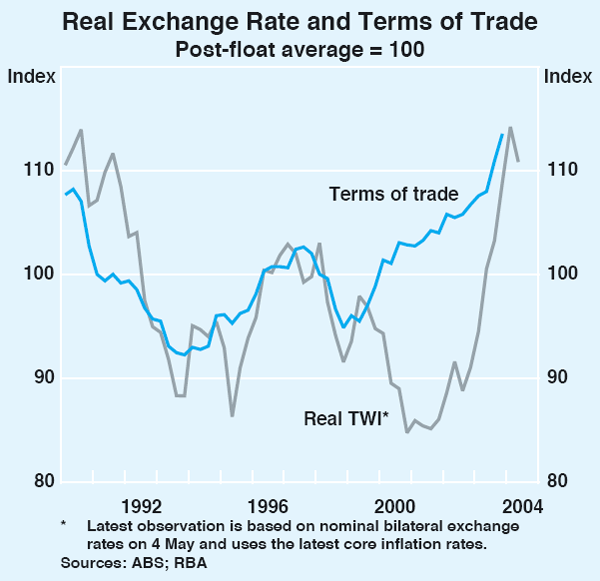
Inflation Trends and Prospects
Recent developments in inflation
The Consumer Price Index rose by 0.9 per cent in the March quarter to be 2.0 per cent higher over the year (Table 15). In year-ended terms, inflation has fallen significantly from 2.4 per cent recorded in December and just over 3 per cent a year or so ago (Graph 69). The effect of the exchange rate appreciation continues to be evident in falling traded goods prices, while domestic price pressures were again strong. The Bank's assessment, based on a range of different measures, is that underlying inflation over the past year has been at, or slightly above, 2 per cent.
| Quarterly | Year-ended | ||||
|---|---|---|---|---|---|
| December quarter 2003 |
March quarter 2004 |
December quarter 2003 |
March quarter 2004 |
||
| CPI | 0.5 | 0.9 | 2.4 | 2.0 | |
| – Tradables | 0.0 | 0.6 | 0.0 | −0.5 | |
| – Tradables (ex petrol and food) | −0.5 | −0.5 | −0.8 | −1.3 | |
| – Non-tradables | 0.9 | 1.1 | 4.4 | 4.1 | |
| Underlying measures | |||||
| Weighted median(a) | 0.4 | 0.7 | 2.5 | 2.3 | |
| Trimmed mean(a) | 0.4 | 0.6 | 2.3 | 2.1 | |
| CPI excluding volatile items | 0.3 | 0.5 | 2.4 | 2.1 | |
| Market goods and services excluding volatile items |
0.4 | 0.0 | 1.8 | 1.3 | |
|
(a) For more information on these measures see ‘Box D: Underlying Inflation’ in the May 2002 Statement on Monetary Policy. Sources: ABS; RBA |
|||||
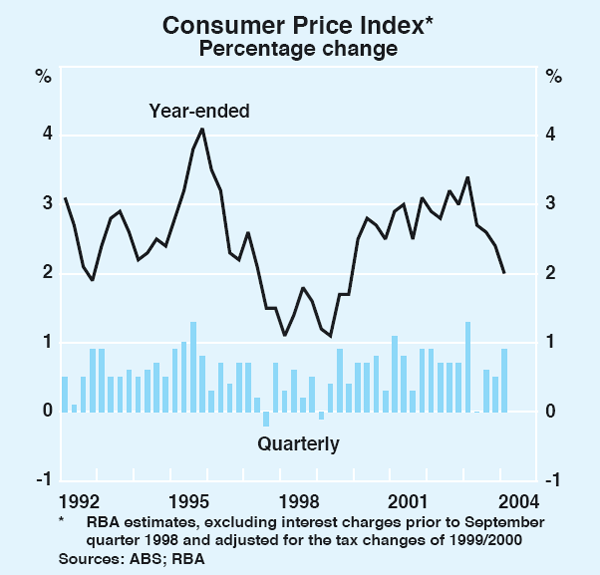
Prices of tradables (excluding volatile items) fell by ½ per cent for the third successive quarter, to be 1.3 per cent lower over the year (Graph 70). In both quarterly and annual terms, there were sizeable falls in prices of a wide range of items, particularly for motor vehicles, audio, visual & computing equipment, and overseas travel & accommodation.
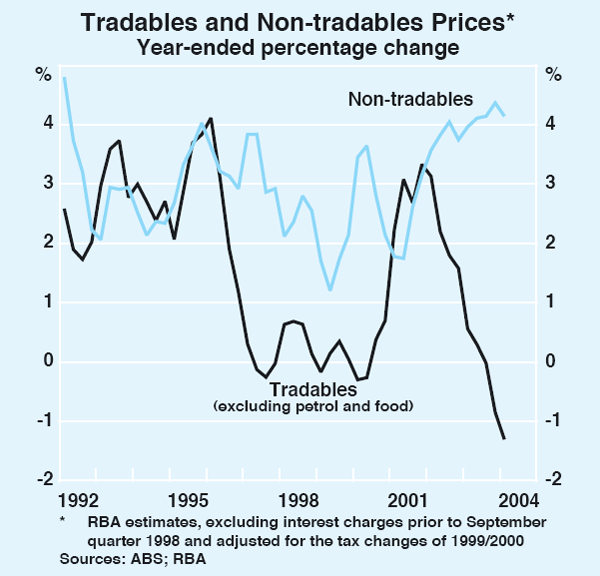
Inflation of non-tradable items was 1.1 per cent in the March quarter and remained above 4 per cent in year-ended terms. Firm price pressures were apparent across a range of non-tradable items. House purchase costs rose by 1.1 per cent in the quarter, and were up by around 6 per cent over the year. Liaison suggests that increases here are being driven in part by labour shortages and higher materials costs. In addition, prices of health and education continued to rise strongly, rising by around 7 per cent in year-ended terms.
Volatile items, such as fruit and vegetables, also contributed significantly to inflation: excluding such items, the CPI rose by only 0.5 per cent in the quarter. There was also a reasonably large contribution to inflation from items with prices that are publicly administered. Market prices, which exclude both administered and volatile items, were flat in the quarter and up by only 1.3 per cent in the year. In contrast, the other measures of underlying inflation were somewhat higher, at just over 2 per cent.
Producer Prices
Indicators of producer price inflation by stage of production confirmed the sharp contrast between domestic and external sources of inflationary pressure. Domestically sourced inflation was a little stronger in the March quarter, with domestic inflation at the final stage of production rising to 4.1 per cent in year-ended terms. In contrast, imported producer prices continued to fall; at all stages of production they were 3 to 5 per cent lower in the quarter, and fell by around 15 per cent over the year (Table 16).
| March quarter 2004 |
Year to March quarter 2004 |
Year to December quarter 2003 |
|
|---|---|---|---|
| Preliminary | −0.1 | −2.7 | −1.5 |
| – Domestic | 0.5 | −0.5 | 0.4 |
| – Imported | −4.4 | −15.8 | −12.5 |
| – Excluding oil | 0.0 | −1.1 | −0.6 |
| Intermediate | −0.2 | −2.3 | −1.1 |
| – Domestic | 0.5 | 0.0 | 0.9 |
| – Imported | −4.8 | −15.7 | −12.6 |
| – Excluding oil | −0.2 | −1.3 | −0.6 |
| Final | 0.6 | 0.9 | 1.0 |
| – Domestic | 1.4 | 4.1 | 4.2 |
| – Imported | −3.7 | −13.6 | −12.6 |
| – Excluding oil | 0.5 | 1.1 | 1.0 |
|
Source: ABS |
|||
At the final stage of production, construction costs continued to contribute significantly to price inflation, rising by 2.4 per cent in the quarter and by 8.2 per cent over the year. The Davis Langdon Tender Price Index – which prices a fixed basket of labour and material inputs typically used in commercial and apartment construction – confirms this trend, though there are emerging signs that costs may have peaked in some regions, particularly Melbourne (Graph 71).
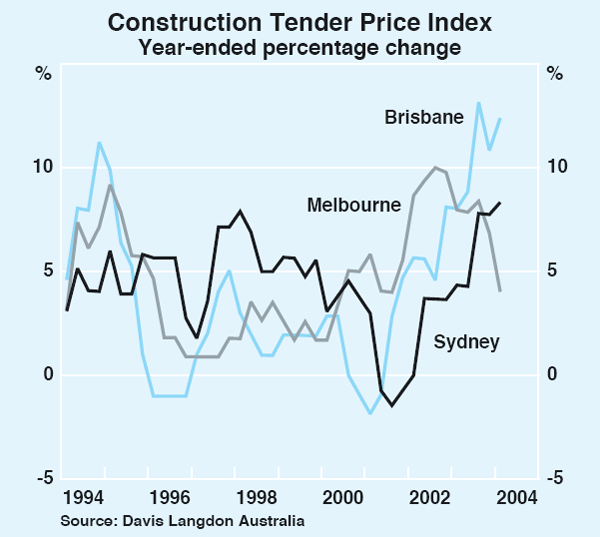
Labour costs
Most labour cost indicators suggest that wages growth edged higher in the second half of 2003. This is consistent with signs that labour-market conditions remained relatively firm. In the December quarter, the wage cost index (WCI) for total pay increased by 1.0 per cent, to be 3.7 per cent higher than a year earlier (Graph 72). Similarly, unit labour costs (based on compensation per hour worked) picked up a little in the December quarter, rising by 1.4 per cent to be 2.3 per cent higher than a year ago. This annual growth rate is close to the average of the past few years.
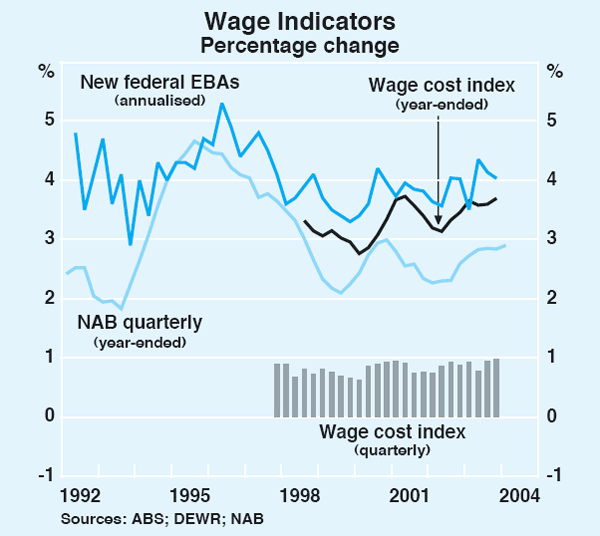
The pick-up in the WCI data in the second half of 2003 partly reflected the spreading out of increases in wage pressures to a broader range of industries, after having been concentrated in public-sector and related industries earlier in the year (Table 17). Growth in wage costs increased in manufacturing, retail trade and property & business services. Labour cost pressures also remain firm in the construction sector; a recent survey by the Master Builders Association suggests that labour shortages remain most acute in trades exposed to the latter stages of the building process, contributing to ongoing pressure on rates for subcontractors.
| Industry | Employment share Per cent | June quarter 2003 |
December quarter 2003 |
|---|---|---|---|
| Retail trade | 15.8 | 1.8 | 4.5 |
| Property & business services | 12.1 | 2.3 | 5.1 |
| Manufacturing | 11.7 | 2.5 | 4.7 |
| Health & community services | 10.6 | 4.5 | 6.1 |
| Construction | 8.4 | 3.5 | 3.6 |
| Education | 7.6 | 4.7 | 2.3 |
| Accommodation, cafes & restaurants | 5.1 | 1.6 | 3.6 |
| Other | 28.7 | 2.8 | 4.5 |
| Total | 100.0 | 3.1 | 4.4 |
|
Source: ABS |
|||
Data from the Department of Employment and Workplace Relations (DEWR) indicate an average annualised rate of wages growth of 4.0 per cent incorporated into new enterprise bargaining agreements (EBAs) certified in the December quarter. This remains at the higher end of outcomes over the past few years, though slightly below the most recent peak of 4.4 per cent in June 2003. Wage increases for the stock of existing agreements averaged 3.9 per cent in the December quarter, slightly higher than the average rate since mid 2002. The Mercer Quarterly Salary Review indicated that annual growth in the base salaries of executives increased marginally to 4.7 per cent in the March quarter, after picking up over the second half of last year. In its Safety Net Review decision, the Australian Industrial Relations Commission granted a $19 increase in award rates of pay. As a result, the federal minimum wage increased by 4.2 per cent to $467.40 per week.
Inflation expectations
The various measures of inflation expectations have diverged a little of late, though the differences are not great, and most observers continue to regard the inflation outlook as benign (Table 18). Among financial market economists surveyed by the Bank, the median inflation expectation has risen slightly in the near term. This is partly due to higher-than-expected quarterly inflation in March, but it also seems to indicate some upward revision to expectations for the June quarter. Longer-term expectations are only slightly higher than they were in February. In contrast, union officials revised their inflation forecasts down slightly, though they remain higher than those of financial market economists at longer horizons.
| Year to June 2004 | Year to June 2005 | |||||
|---|---|---|---|---|---|---|
| November 2003 |
February 2004 |
May 2004 |
February 2004 |
May 2004 |
||
| Market economists(a) | 2.2 | 2.1 | 2.5 | 2.4 | 2.5 | |
| Union officials(b) | 3.0 | 2.6 | 2.4 | 3.0 | 2.9 | |
| (a) RBA survey (b) ACIRRT survey |
||||||
Business surveys continue to suggest that the near-term outlook for inflation is subdued. The quarterly NAB business survey reported that inflationary pressures are expected to decline marginally in coming months, and the ACCI-Westpac survey of manufacturing firms points to a more pronounced reduction in inflationary pressures. Manufacturers surveyed by the AIG indicate that falls in their selling prices are in prospect in coming quarters.
Among consumers, measures of inflation expectations were a little higher. According to the Melbourne Institute survey, the median expectation for consumer price inflation over the coming year rebounded to 4.6 per cent in April from last month's reading of 3.6 per cent (Graph 73). Looking through the monthly volatility, this series has shown no trend over the past few years.
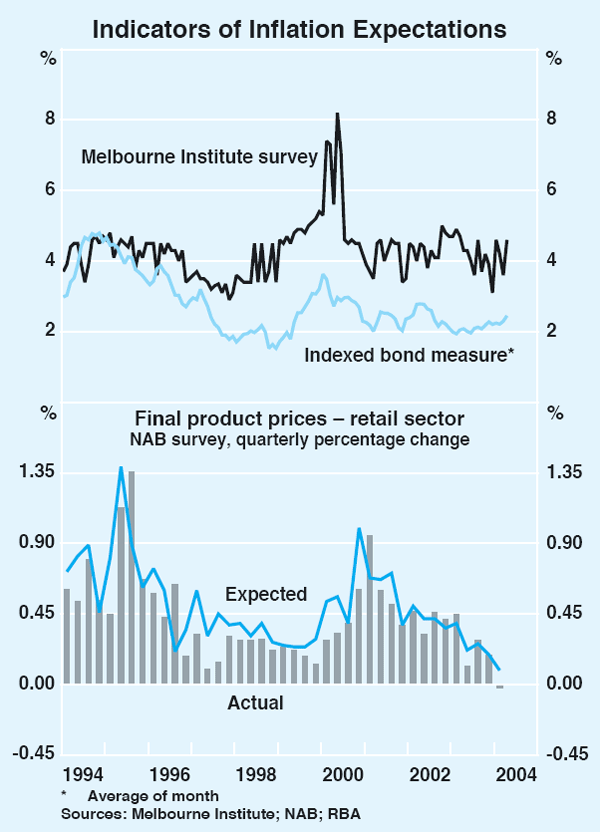
By contrast, the longer-term inflation expectations of financial market participants have risen slightly over the past three months. Expectations of inflation, as measured by the difference between nominal and indexed 10-year bond yields, are now around 2.5 per cent. In part, this increase might be a mechanical response of nominal yields to developments in world bond markets, rather than signalling a lasting change in the financial market's view of the inflation outlook in Australia.
Inflation outlook
The Bank estimates that underlying inflation in year-ended terms eased further in the March quarter to a little above 2 per cent. This development had been broadly anticipated in previous Statements, though the most recent decline was slightly less than expected. The overall decline in inflation from its peak a year ago reflects the continuing effects of the appreciation of the exchange rate. These effects are likely to continue to dampen inflation in the short term, though they should start to dissipate towards the end of this year, after which the inflation rate is expected to move up to levels more in line with its domestic determinants. As a result, underlying inflation is likely to trough at an annual rate of around 1¾ per cent at the end of 2004, rising to around 2½ per cent by late 2005.
CPI inflation in year-ended terms should stay in a narrow range around this profile over much of the forecast horizon, though volatility in oil and food prices over the past year will continue to have some effect on the year-ended figures in future quarters. In addition, CPI inflation will be dampened slightly during 2005 by a range of tariff reductions. These forecasts incorporate the usual technical assumptions of an unchanged exchange rate around recent levels, and a gradual decline in international oil prices to around their medium-term average in US dollar terms.
The domestically generated risks to this outlook lean slightly toward the upside. The demand pressures already apparent in some sectors might increase and therefore add more to domestic cost pressures than is currently expected. In addition, the global economy has clearly gained momentum over recent months and could accelerate further, creating an increasingly favourable environment for growth of the Australian economy in the period ahead. Over time, the stronger global environment could also generate further upward pressure on commodity prices and hence manufacturing costs, and on traded goods prices more generally.
The main source of downside risk to inflation identified in the previous Statement was associated with the appreciation of the exchange rate. In particular there had appeared a risk that the exchange rate would continue to appreciate, or that the appreciation to date would be passed through into prices more fully than expected, as a result of competitive pressures in the retail sector. In these circumstances, inflation in the short term would decline more quickly than forecast. These risks have decreased somewhat over the past three months. The exchange rate has declined from its February peak, while the rate of pass-through into domestic prices has been if anything a little smaller to date than might have been expected.